What Is Multichannel Ecommerce?
Multichannel ecommerce is a practice in which one brand markets products across multiple digital channels. The strategy aims to get products in front of customers where they spend time.
For example: a hat brand might sell products on Instagram because that social media platform is the most popular among their target audience. The same brand sells on Amazon because shoppers love to read online reviews there. And they use their website to sell the hats in direct sales.
Listing the same products for sale on multiple sites builds brand trust and meets your customers where they are.
Like this: Passenger sells products on its own website.
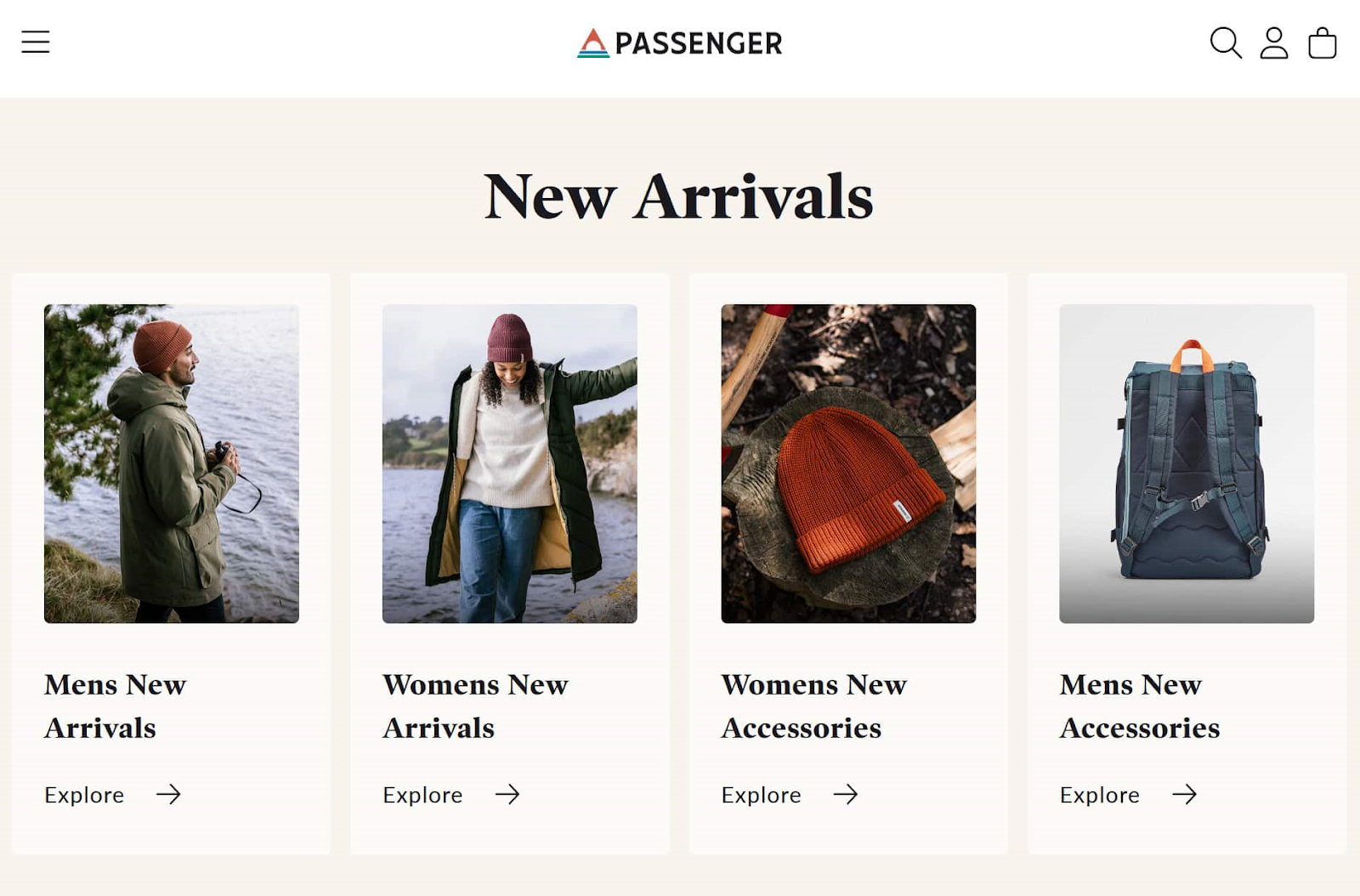
And on Instagram:
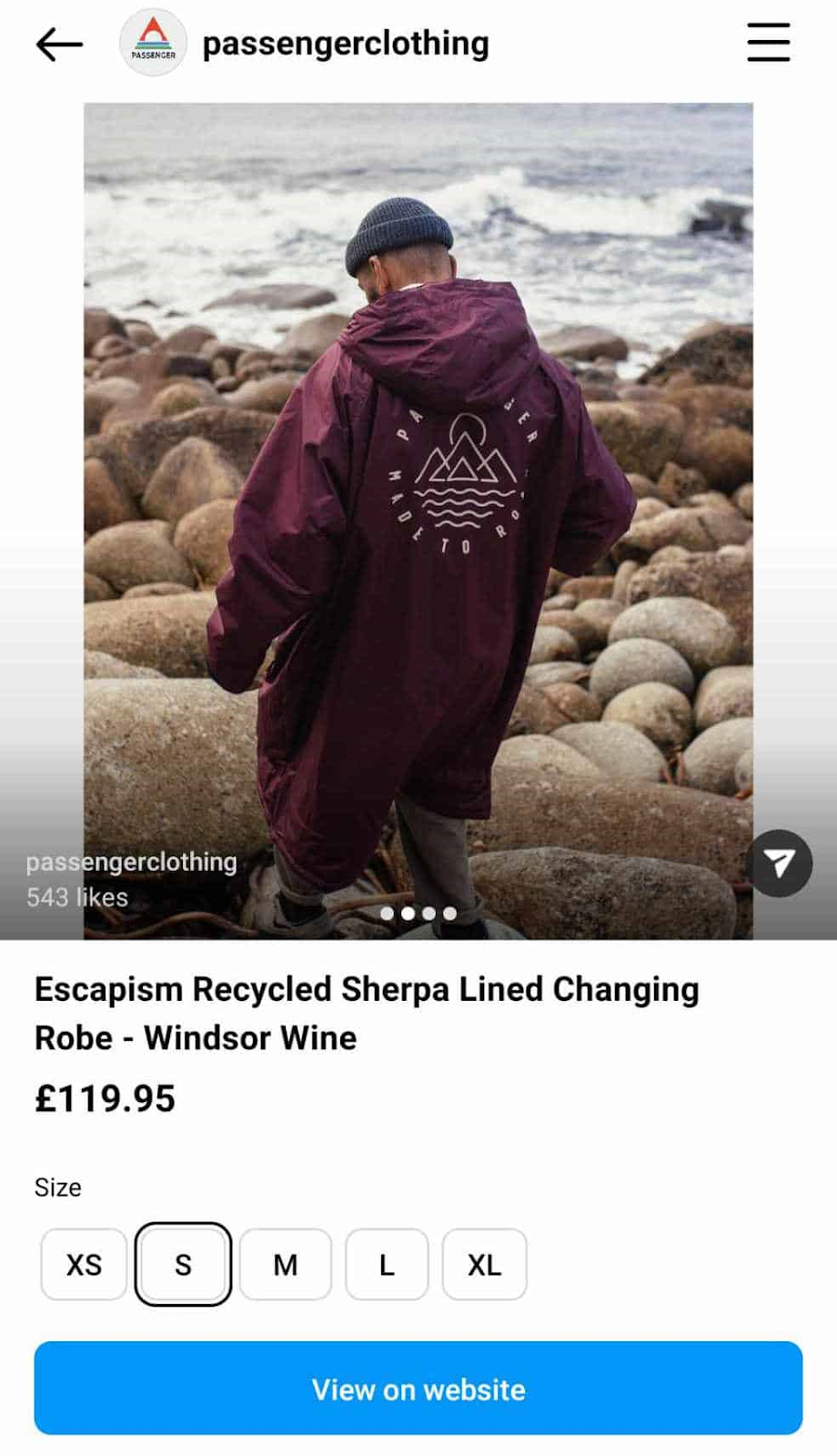
And on Amazon:
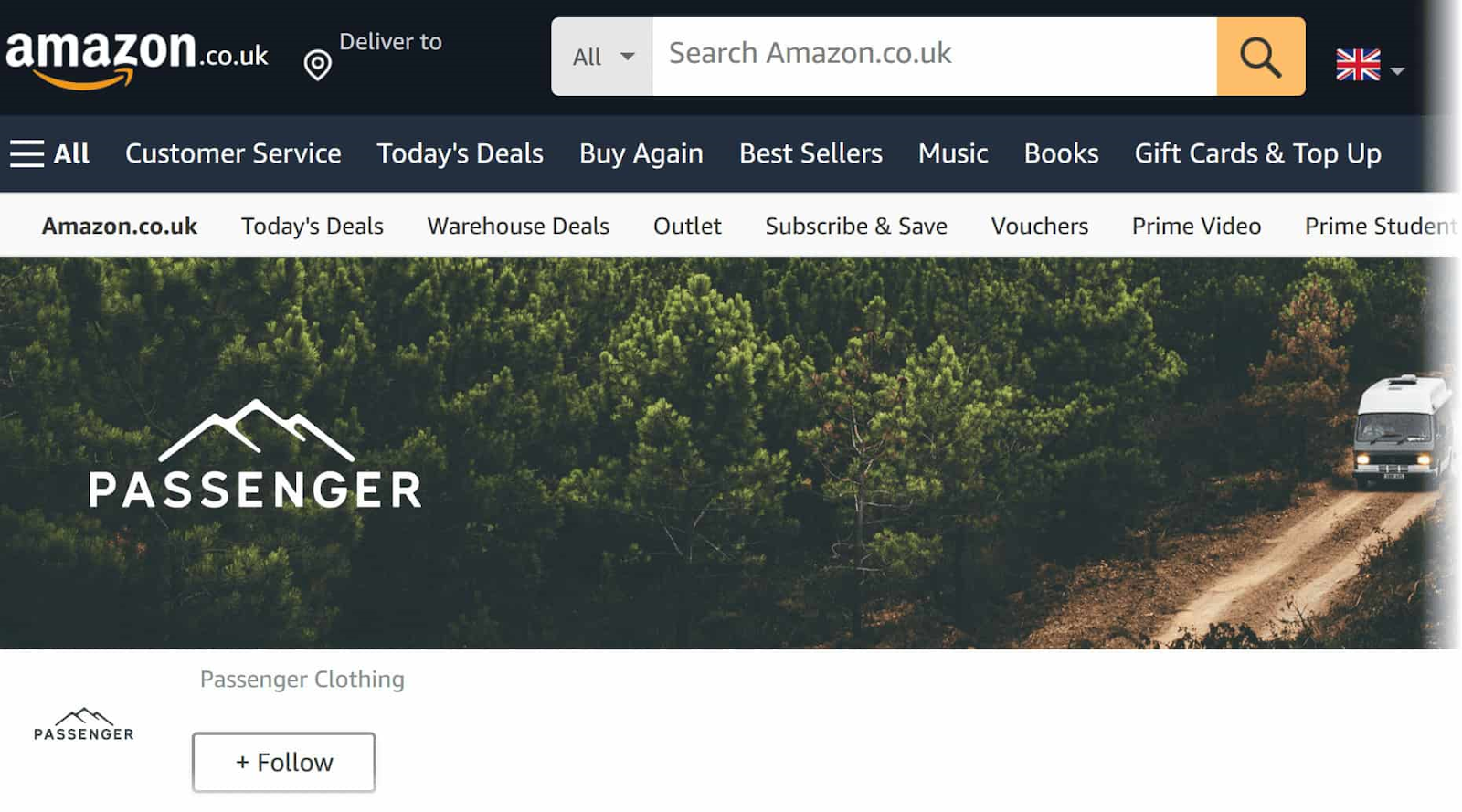
We’ll explain how to sell on multiple platforms without losing orders—or losing your mind—in a minute.
First, let’s clear up the difference between two terms that are often used interchangeably but shouldn’t be.
Multichannel Ecommerce vs. Omnichannel Ecommerce
Multichannel ecommerce marketers use more than one digital channel to reach their customers. The channels aren’t necessarily integrated with one another in terms of appearance or functionality.
In omnichannel ecommerce, the brand has a unified look and feel across channels. And the channels are designed to function well together.
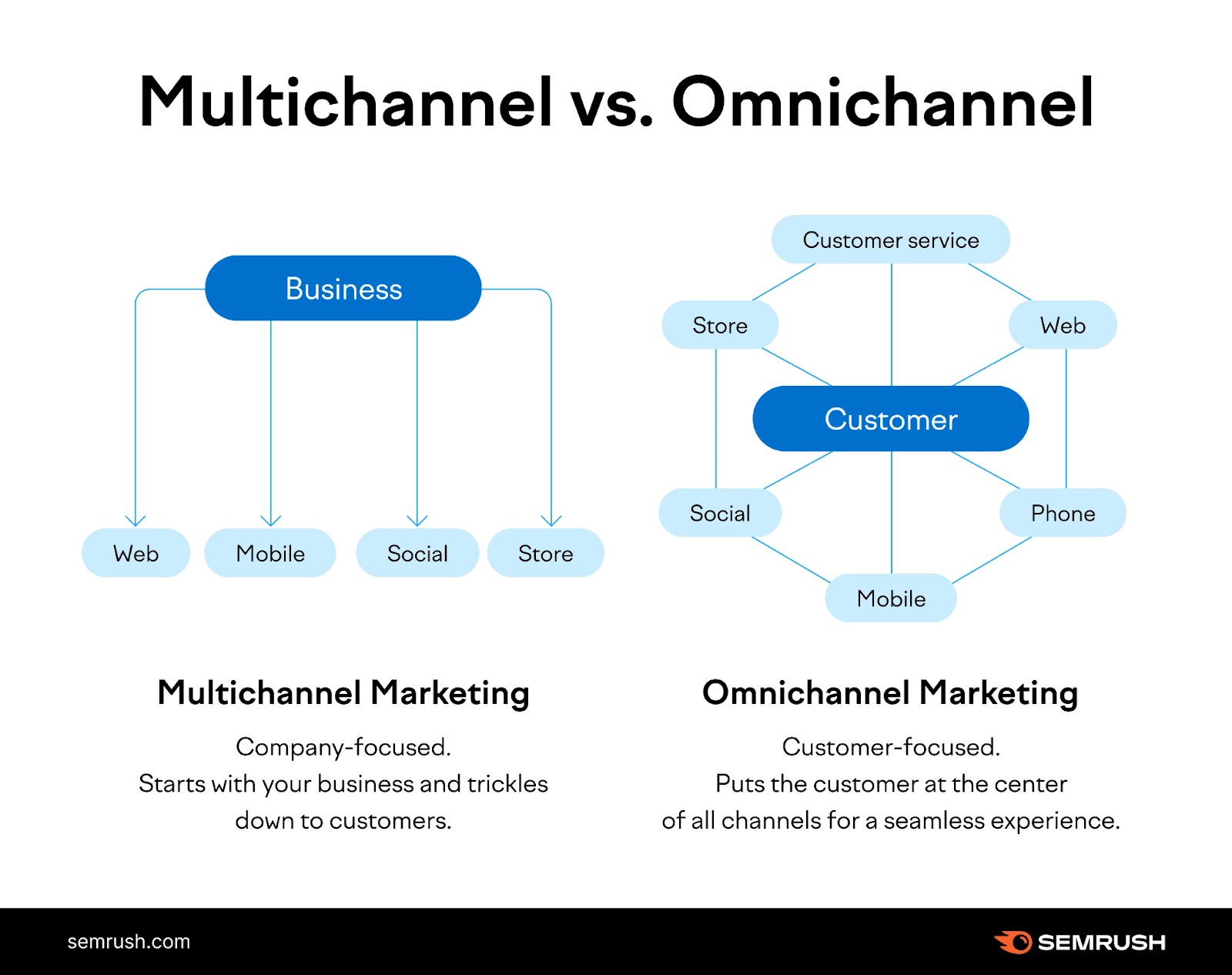
Let’s walk through an example of multichannel ecommerce.
Say someone finds your brand on Instagram. They want to find out more about you. So, they search for you on Amazon. They read reviews there, then—liking what they discovered—they search for your website. They purchase from you directly.
None of these platforms are connected. But they each play a key role in attracting customers.
Now, let’s explore an omnichannel experience.
Someone starts shopping on the Crate & Barrel website on their desktop computer. They add some glasses to their cart.
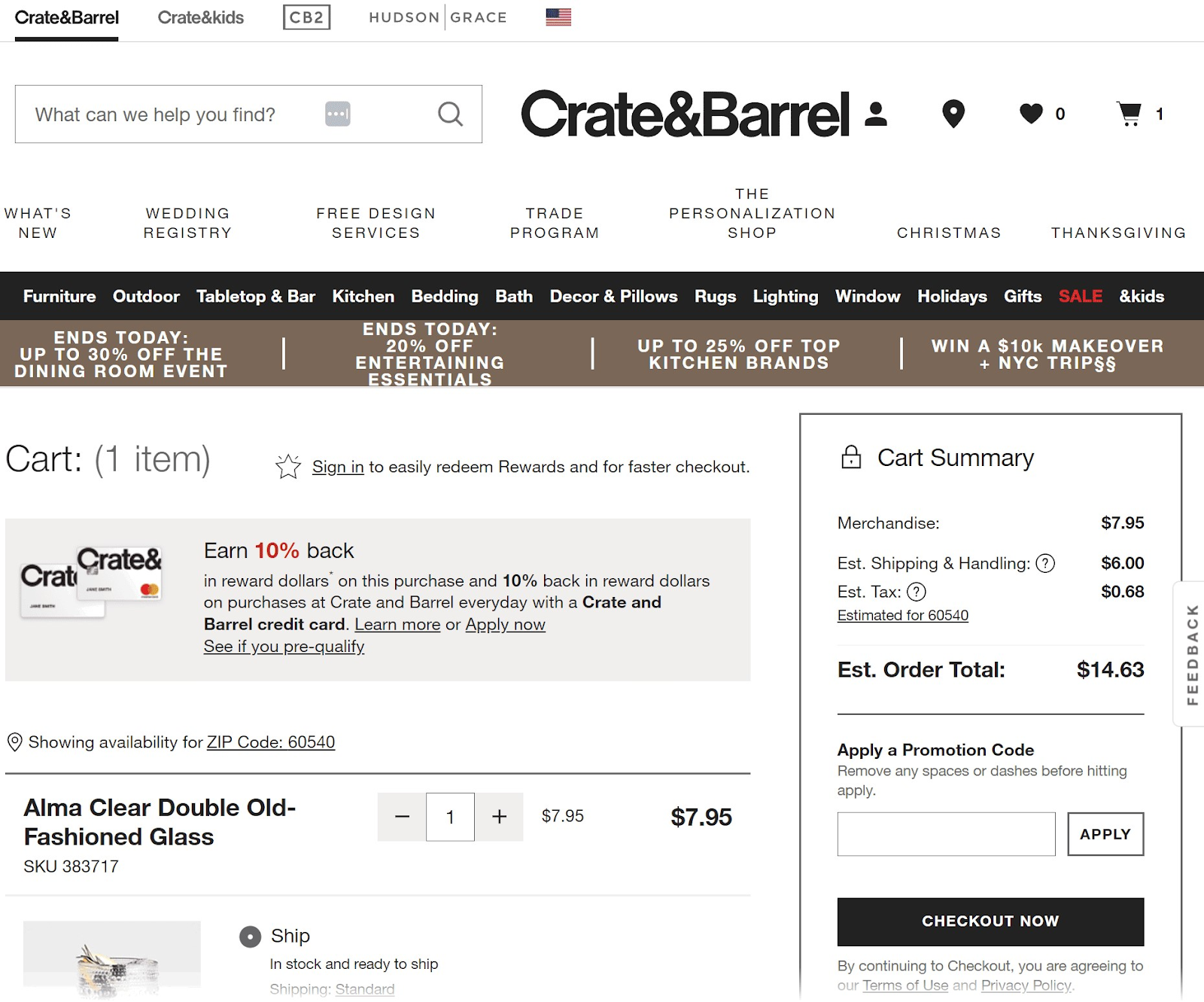
But they get distracted and don’t check out.
Later, when on their phone, they remember those glasses they wanted.
They go to the mobile version of the Crate & Barrel website and see the items in their cart that they added from their desktop computer.
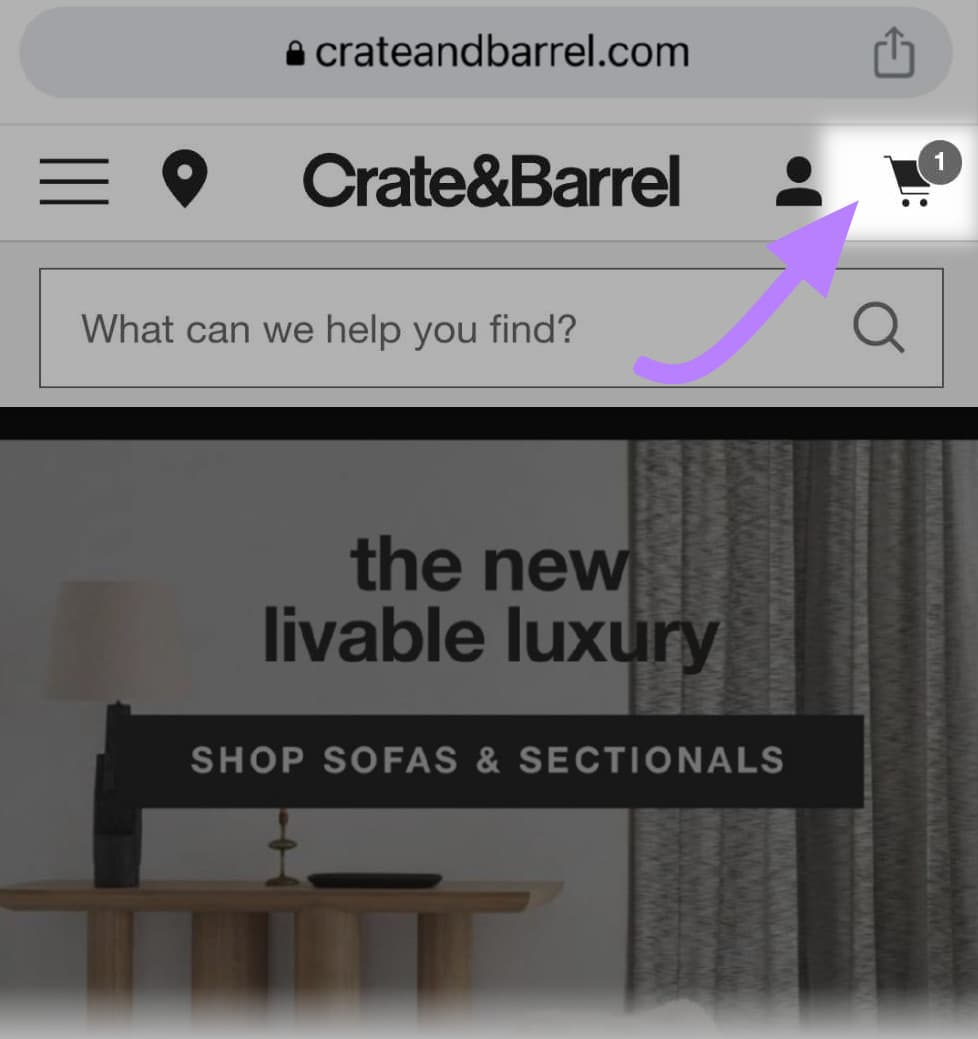
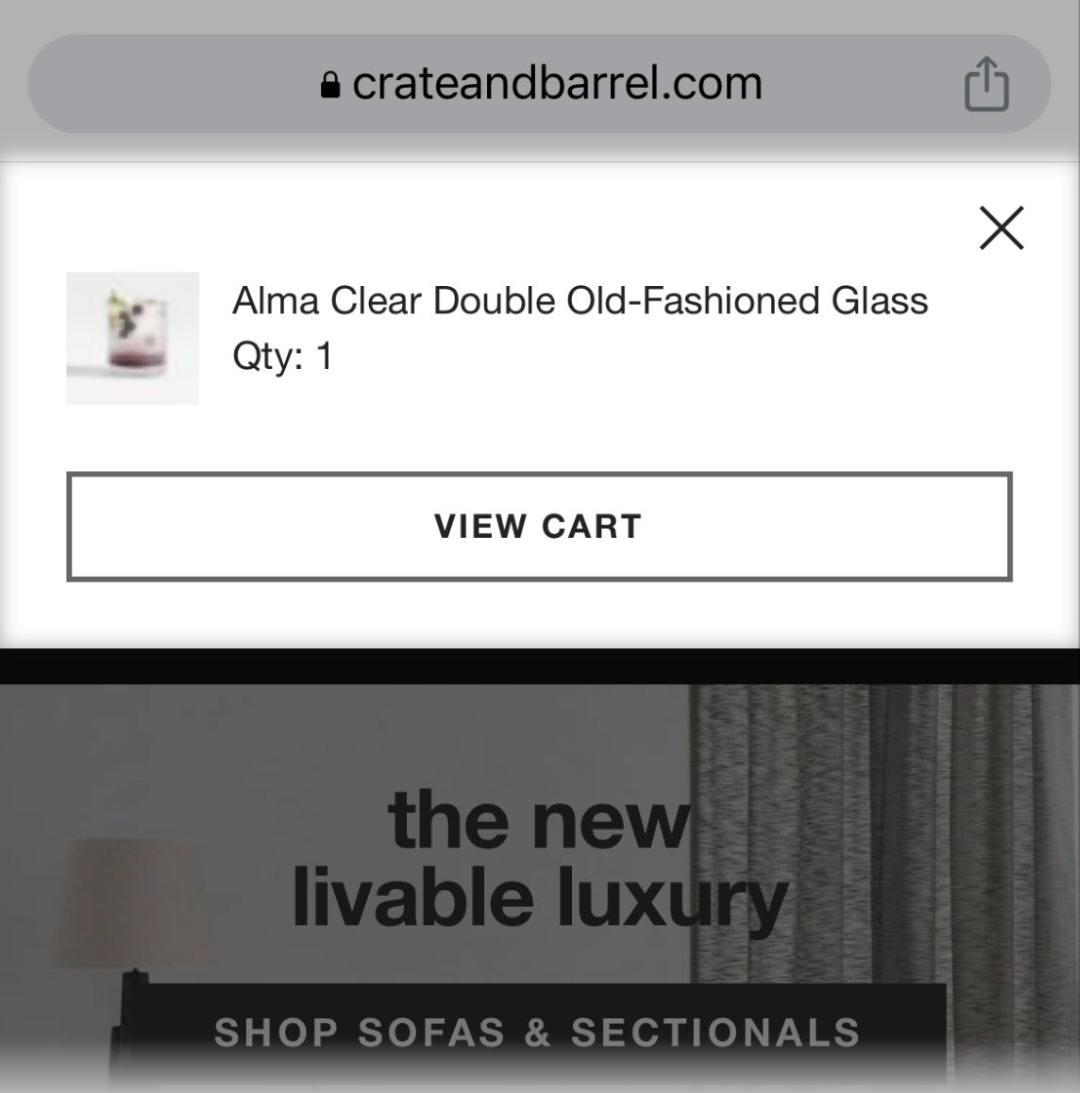
How? Crate and Barrel uses an omnichannel ecommerce strategy. Their tools connect the mobile site and desktop site making it seamless for their customers.
How Does Multichannel Ecommerce Benefit Retailers?
Multichannel ecommerce can benefit your business in three main ways:
- Expanding your customer base
- Increasing brand awareness
- Generating more revenue
Let’s look at each benefit more closely.
It Expands Your Customer Base
Using a multichannel ecommerce approach ensures shoppers can engage with your brand how they want to.
For example, on social media.
Global daily social media usage is now an average of 151 minutes a day. But users only spend around 54 seconds on the average website.
A multichannel ecommerce strategy that includes social media allows prospects to see a product and learn about their options where they already browse. Then rediscover their shopping experience on another channel.
It also provides social proof, which is important because nine out of ten potential customers read reviews before they make a purchase. For 93% of people surveyed, it has the biggest impact on their purchasing decision.
A multichannel approach also suits the way today’s customers shop. Some 78% of them have used multiple channels to start and finish a purchase. If you only sell on your site, you could lose out on customers who jump between channels.
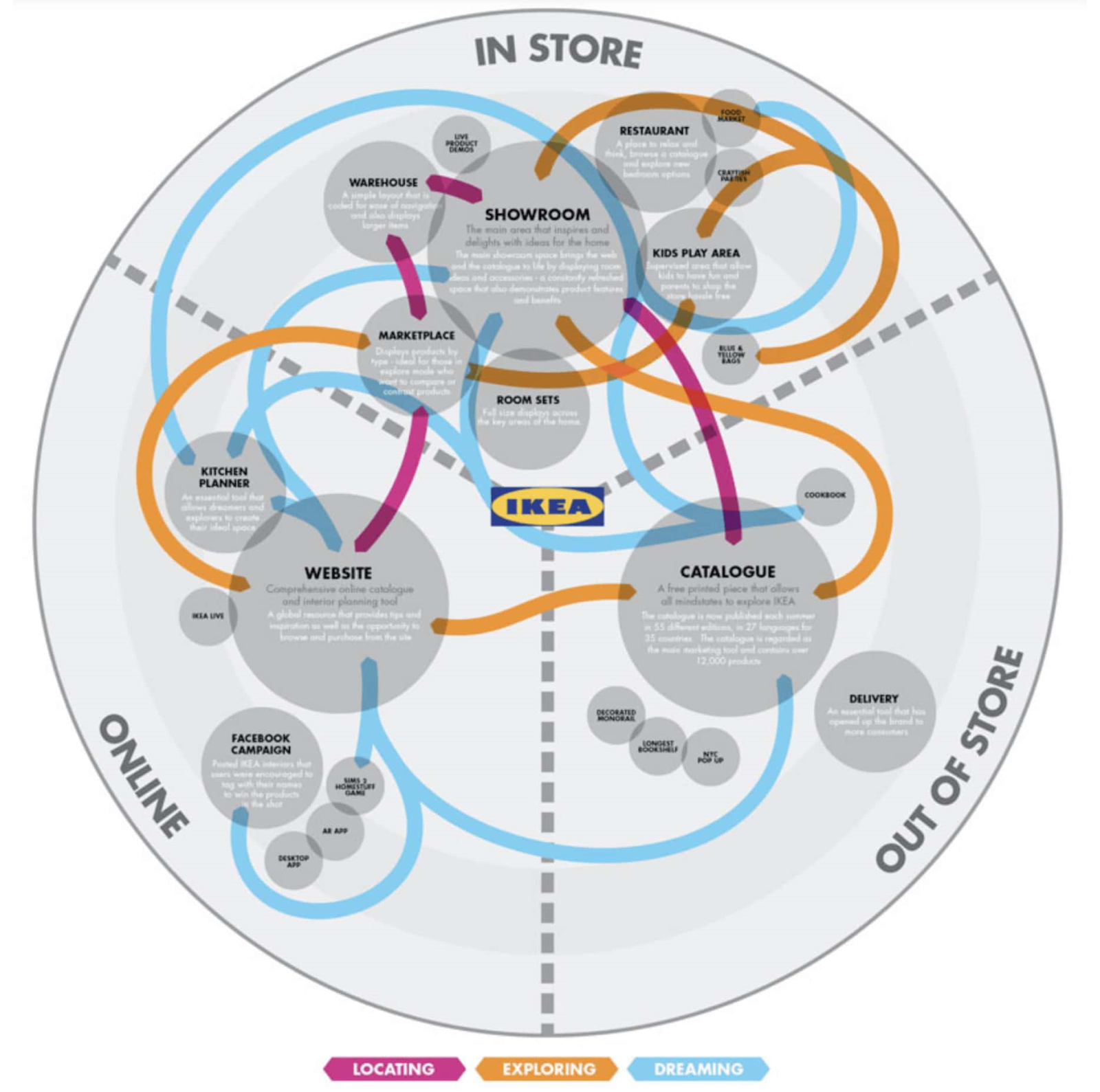
Image Source: Linteri
Multichannel selling gets you in front of more shoppers, where and how they like to browse. That way, you meet people where they are and increase the chance of gaining them as customers.
It Increases Brand Awareness
A multichannel ecommerce approach gives would-be shoppers unfamiliar with your brand more places to discover you online.
Consumers learn about new products in a variety of places, but “searching the internet” still tops them all according to HubSpot.
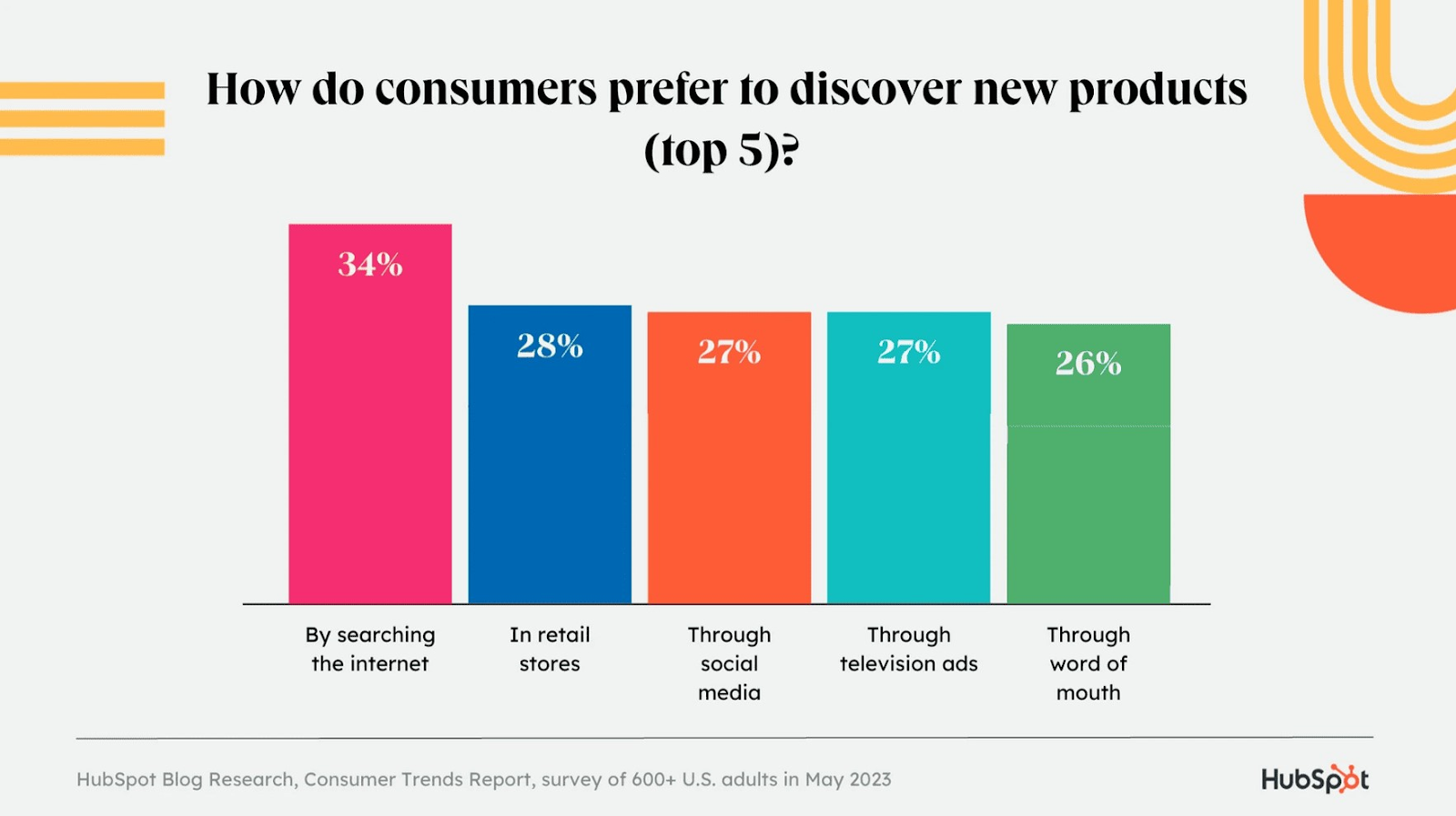
Image Source: HubSpot
The more places potential customers see your brand and products online, the better.
People prefer things that are familiar to them. It’s called the Mere Exposure Effect. The more familiar something is to someone, the more likely they are to pick that option.
Think about the last time you tried a new soft drink: it’s likely you went with a brand you’ve heard about. Not one you’ve never seen before.
The more you build your brand awareness with prominent online promotion—across multiple channels—the more likely your target audience is to pick you when they make a purchase.
It Generates More Revenue
Merchants who use three or more channels create 143% higher revenue than retailers using only one or two, according to Sellbrite research.
Why?
Increasing your touchpoints, brand exposure, and customer base leads to more buyers. Which leads to more revenue.
Choosing Your Ecommerce Channels and Marketplaces
There are plenty of ecommerce channels and digital marketplaces to choose from. But some are more popular than others—on those, you have a decent chance of getting in front of a sizable audience.
Here are some of the most prominent platforms for selling your products online:
Google Shopping
Google Shopping is a specialized feature of Google. It allows searchers to discover, compare, and purchase products from right within the search results.
When a searcher types in a transactional search term, the products listed on top of the SERP are Google Shopping listings.
A Google search for “wine glasses,” for example, brings up options to purchase direct from West Elm, DiscountMugs, Crate & Barrel, and more.
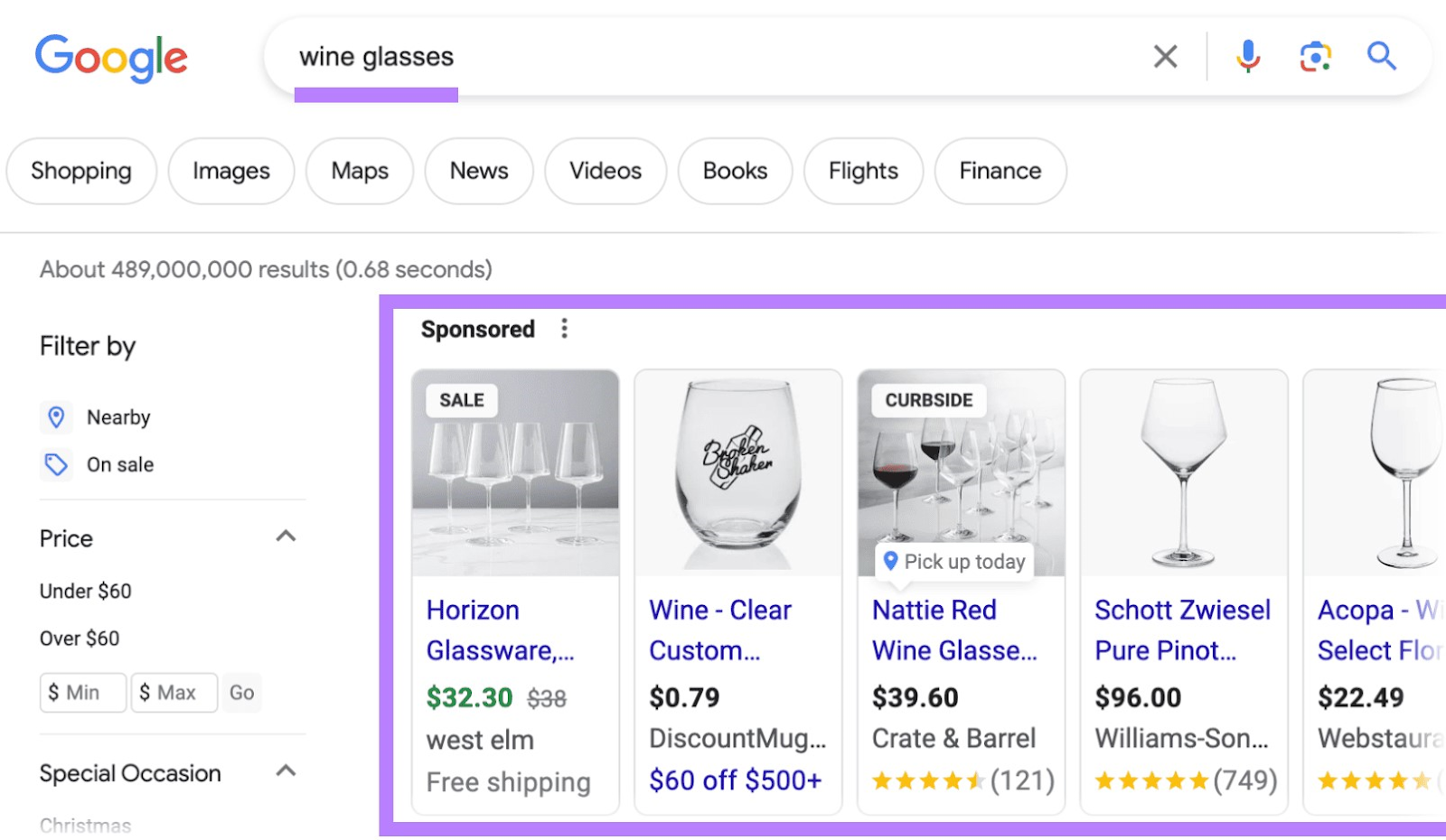
Click the “Shopping” tab under the search bar. You’ll see the entire Google Shopping product catalog related to the search:
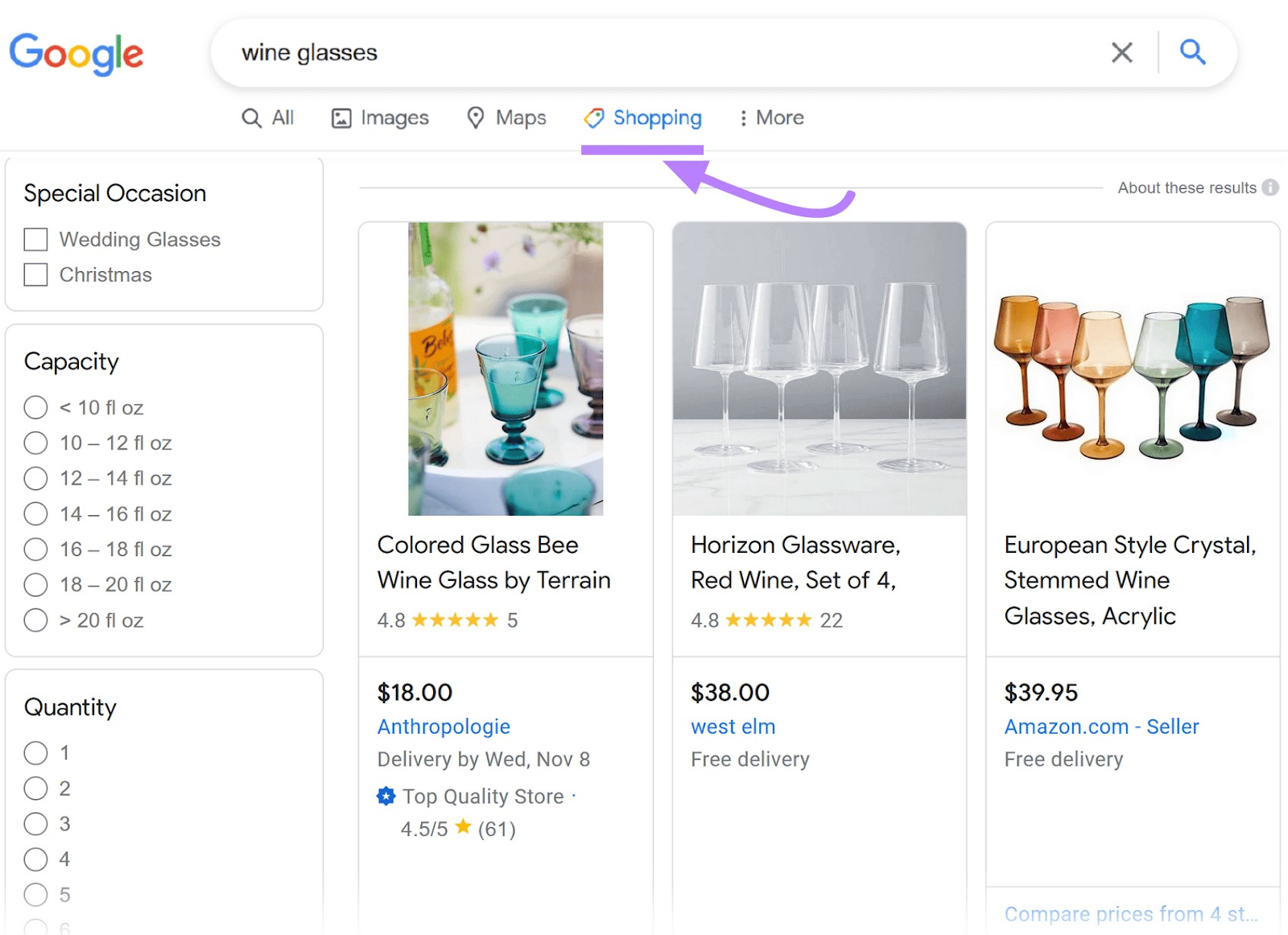
If your products are listed on Google Shopping, your product information can appear in both places when potential customers search for relevant terms.
A free Merchant Center account also lets you place your business and products on:
- Google Maps
- YouTube
- Google Images
It’s a small amount of work for a big potential payoff.
Some businesses have seen a 5% growth in revenue and a 400% increase in online shopping revenue using the service according to Google.
Further reading: A Guide to Google Shopping Ads for Any Business
Amazon
Amazon is the world’s biggest online retailer. Third-party sellers can list their products on its ecommerce platform, Amazon Marketplace.
Here’s what your Amazon storefront could look like:
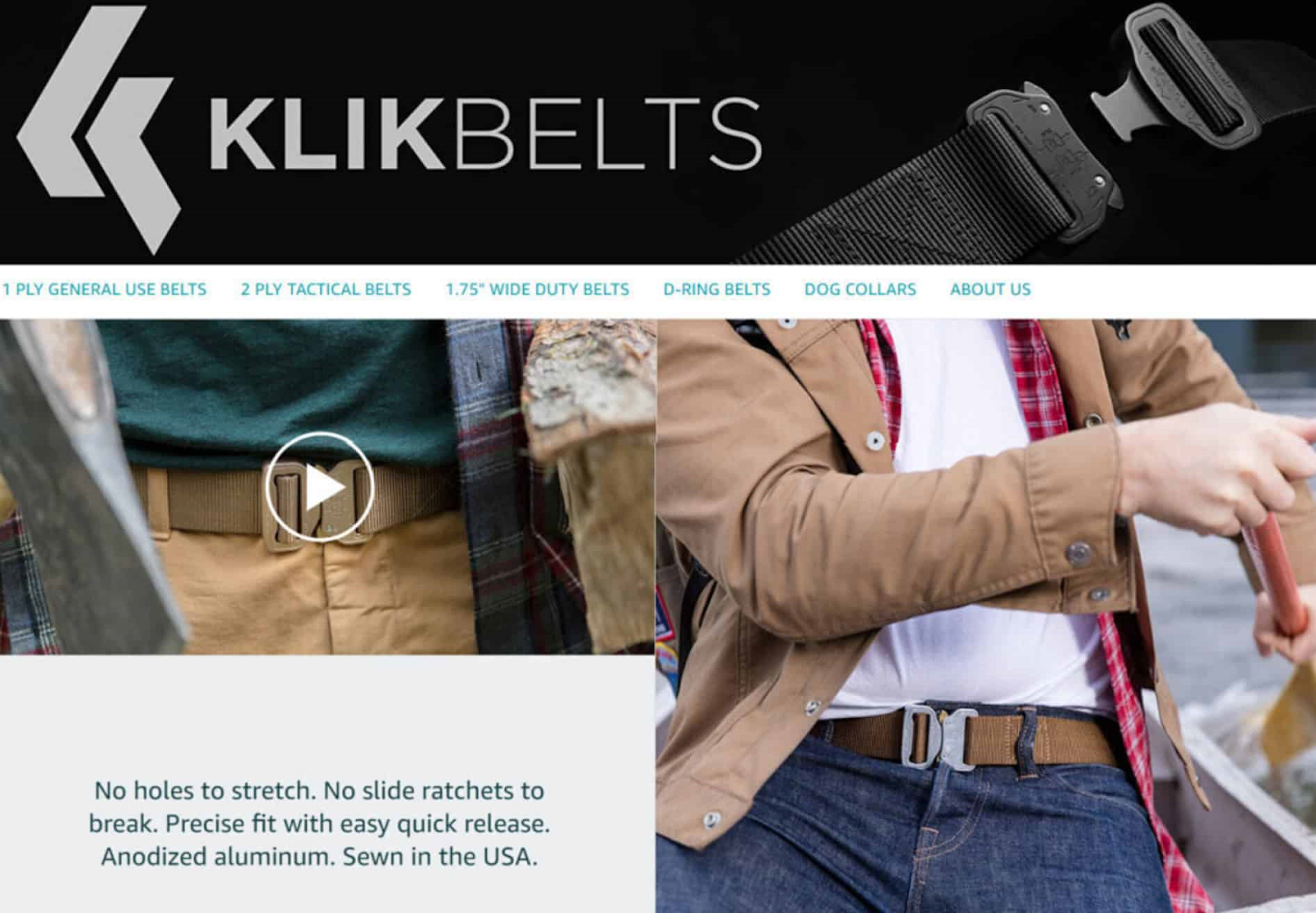
Selling here gives your ecommerce business instant credibility. Amazon is the third most-trusted brand in America according to research by Morning Consult.
Another perk? The Fulfillment by Amazon (FBA) service allows you to store your stock in Amazon’s fulfillment centers. The company picks, packs, and ships your orders. And it provides support for customer queries.
Sellers see a roughly 20–25% sales increase when they adopt FBA according to the platform. Perhaps that’s why small and medium-sized businesses (SMBs) products make up around 60% of Amazon’s sales.
The costs to sell on Amazon vary depending on the products you sell and how you choose to sell them.
Further reading: Learn how to make your products appear higher in Amazon’s search results with Amazon SEO: How to Rank Your Products on Amazon.
Walmart Marketplace
Walmart Marketplace is one of the fastest-growing US ecommerce platforms. It has over 128 million monthly visitors according to Comscore.
Your product listing will look like any other product listing on the Walmart site:
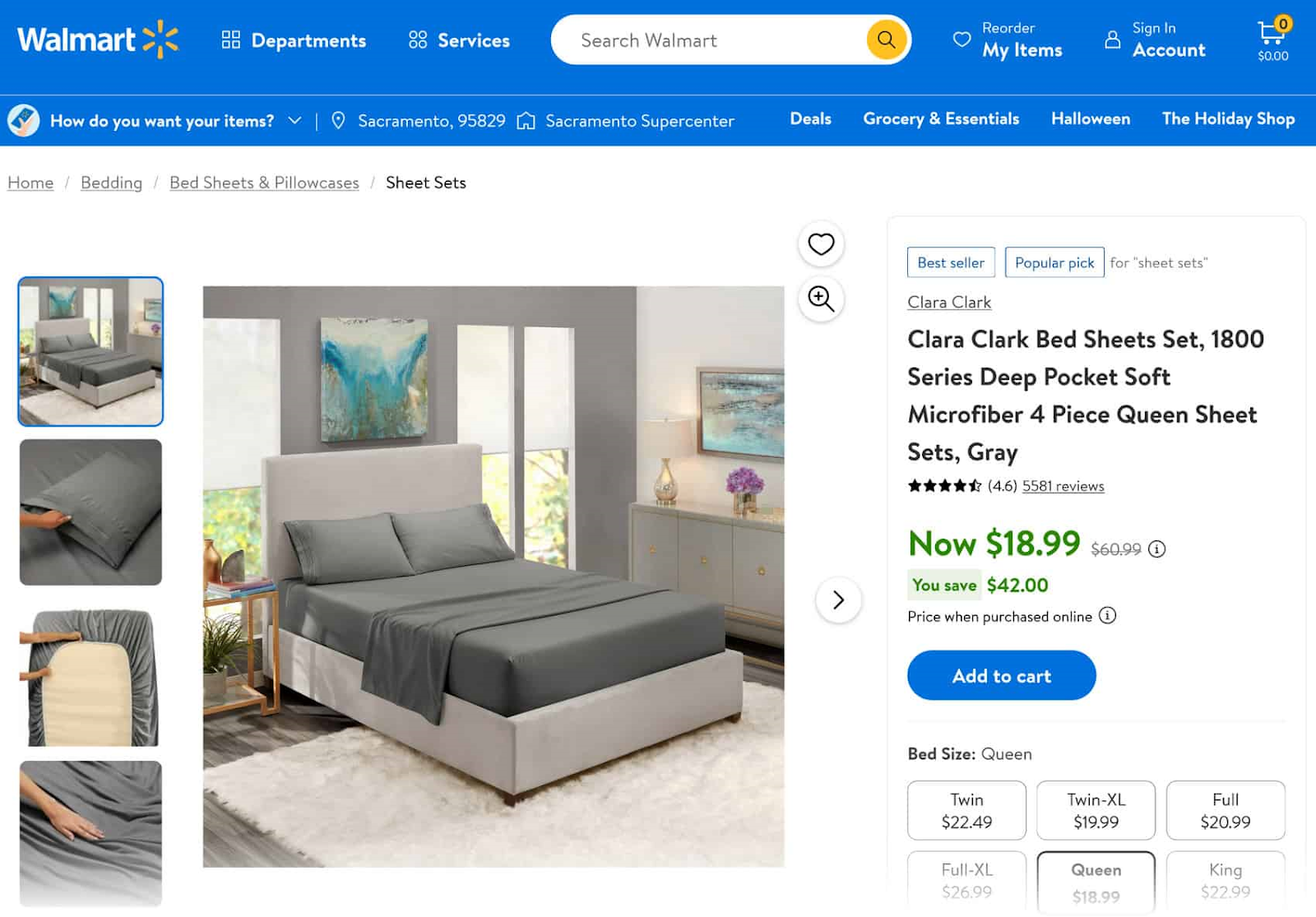
However, it’ll include details like these in the fulfillment and shipping section:
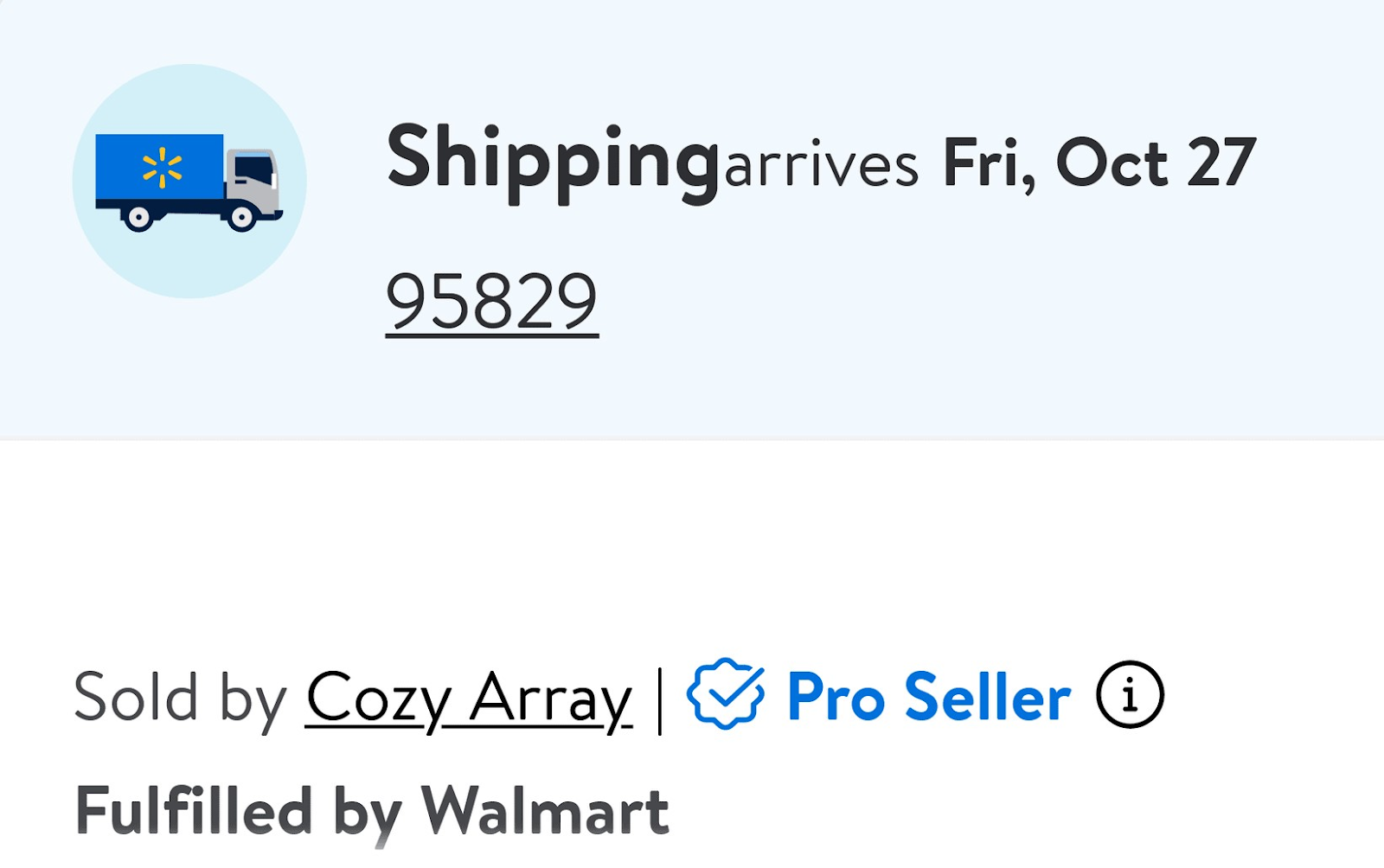
Just like with Amazon, you get to take advantage of Walmart’s enormous brand authority and customer base. (Thanks to its dominance as a brick-and-mortar store.)
But only qualified businesses can sell here. You can find the baseline requirements on Walmart’s site.
If you meet those criteria, you can sign up and complete three steps to join.
After Walmart Marketplace approves your account, you can integrate your online store’s products with it in three ways:
- Using ecommerce solution providers (we’ll cover some in the next section)
- Integrating with Walmart Marketplace’s API (you might need a developer’s help for this)
- Configuring within the Seller Center (via “Setup by Match,” “Single Item,” or “Bulk Upload Setup” in settings)
Walmart also offers end-to-end fulfillment services to help you reach as many customers as possible.
eBay
Ebay is an online shopping and auction platform. And it’s the second most-visited ecommerce site in the US. Ebay had 134 million active buyers at the end of 2022 according to the company’s annual report.
Here’s what your eBay store could look like:
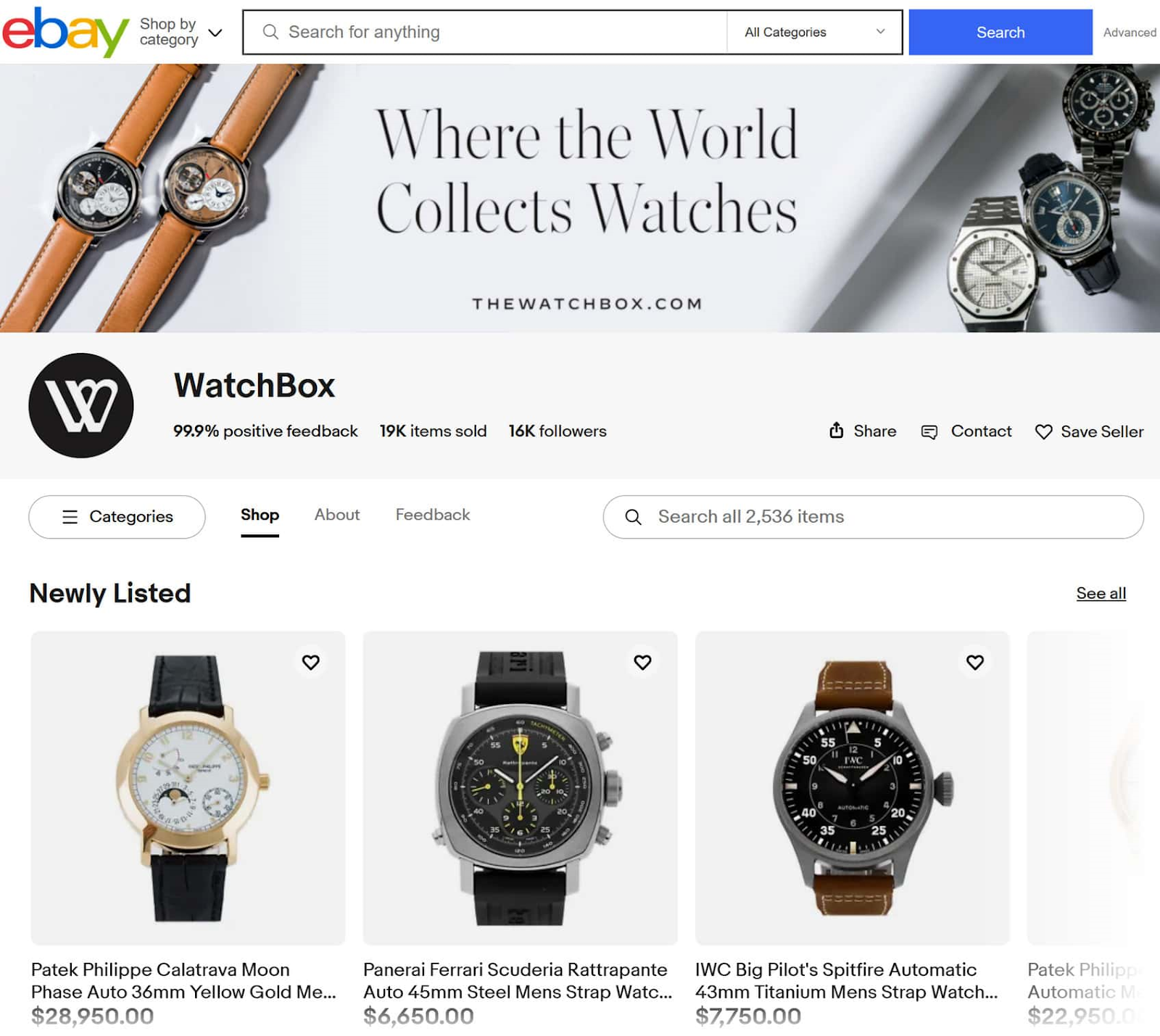
The review system on Ebay gives potential customers instant social proof that your business is trustworthy. When they see others trust and favorably rate your brand, they’re more likely to as well.

Plus, this built-in feedback system means shoppers don’t have to leave the site to do research while they consider a purchase.
You can use your eBay Seller Hub as a customer support and order management platform. It also provides listing guidance help and sales metrics to help you hone your strategy.
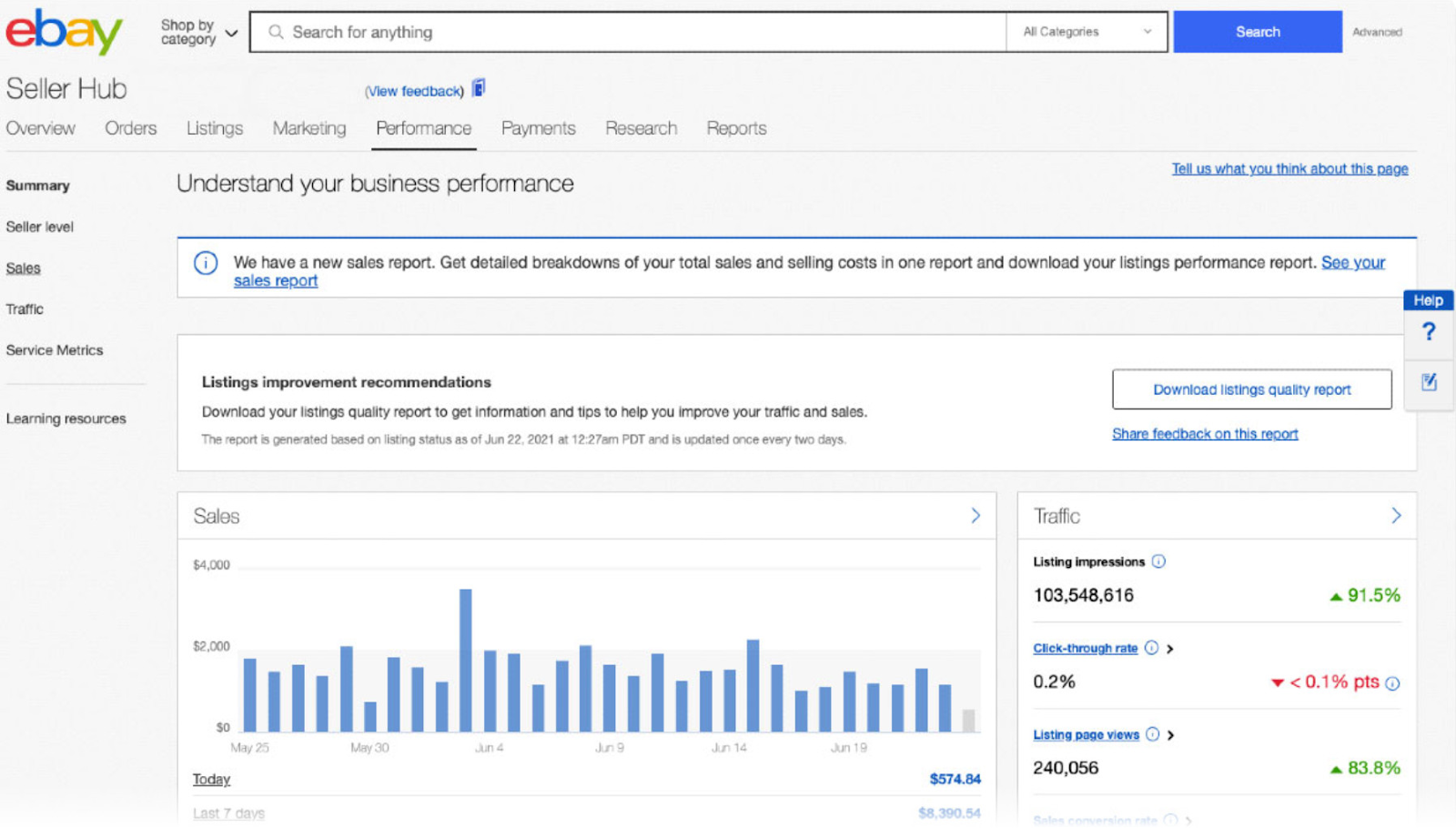
Image Source: eBay
To sign up, create an eBay Business account.
Set up your shipping, return, and payment preferences. Then upload your inventory.
The store package you choose dictates the fees you pay.
Etsy
Etsy is an online marketplace for sellers of handmade products, vintage items, and craft supplies. It’s perfect for independent creators who sell niche, artisan products.
Here’s what your Etsy storefront could look like:
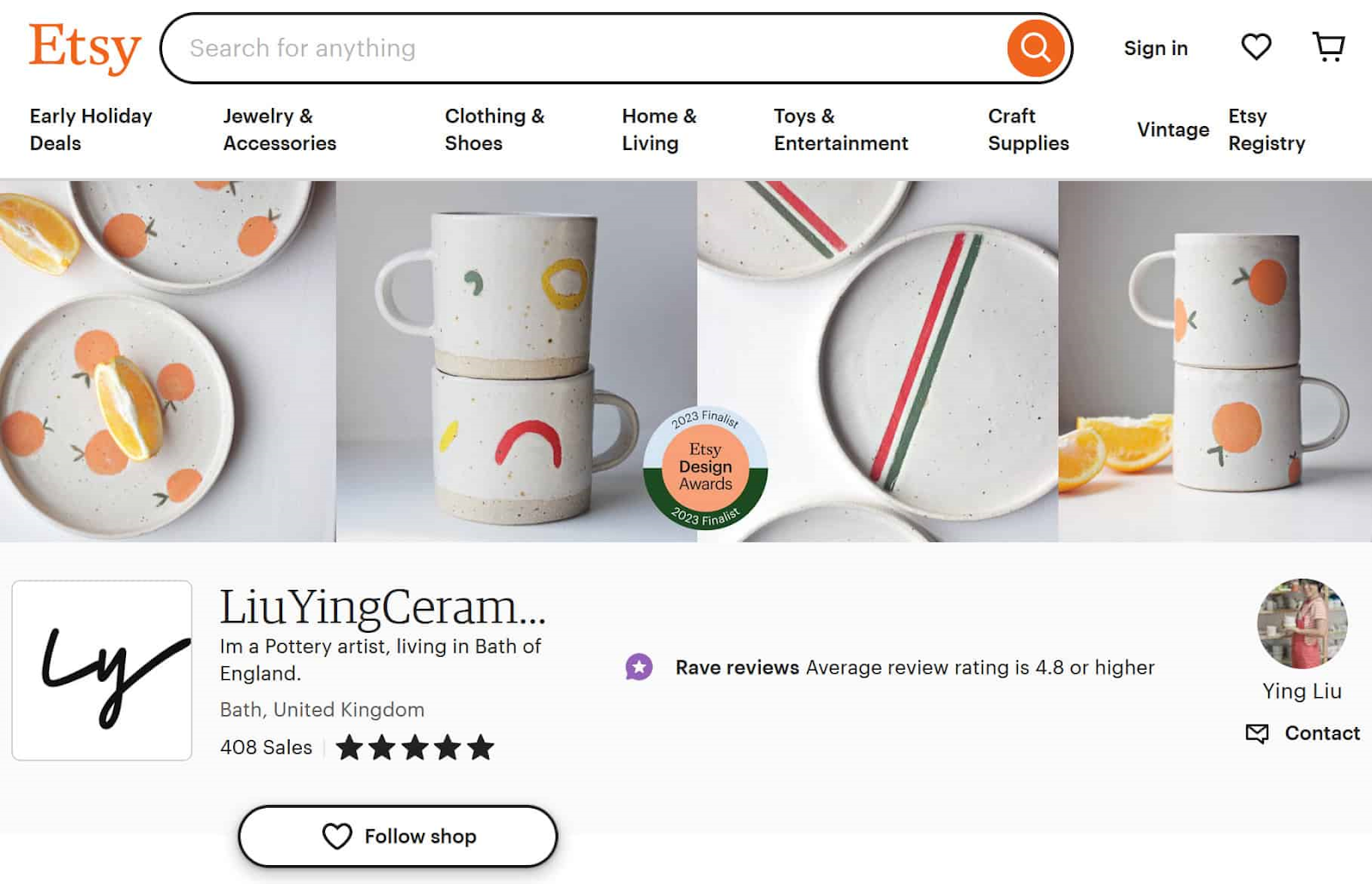
This is an especially good platform for shoppers and brands that want to support female-owned businesses. Almost 80% of sellers on the platform identify as women according to Etsy. And for nearly half of those, Etsy was the first marketplace they chose to sell their goods on.
It’s easy to get started with Etsy, particularly if you don’t have a lot of startup capital. That’s likely why it’s the first platform many sellers use.
Etsy charges $0.20 per listing. And it takes 6.5% of the listing price per sale.
Because so many independent sellers began their journey on Etsy, it has a strong community feel. There are no big names like Walmart or Amazon.
Big brands understand the power of the platform.
Amazon launched its own “Amazon Handmade” community in 2015 with extra benefits to compete with Etsy.
Amazon Handmade takes 15% of each sale and charges a $39.99 monthly fee. It also has strict requirements, such as prohibiting mass-produced products, and it can take a few weeks for Amazon to approve your account.
Selling on Amazon can give you additional exposure due to its popularity. But Etsy’s lower fees can mean more profit.
Create an Etsy account to set up your own shop.
You don’t need a business license. But you do have to follow local laws and regulations pertaining to small businesses.
Once you’ve chosen a shop name, upload your items.
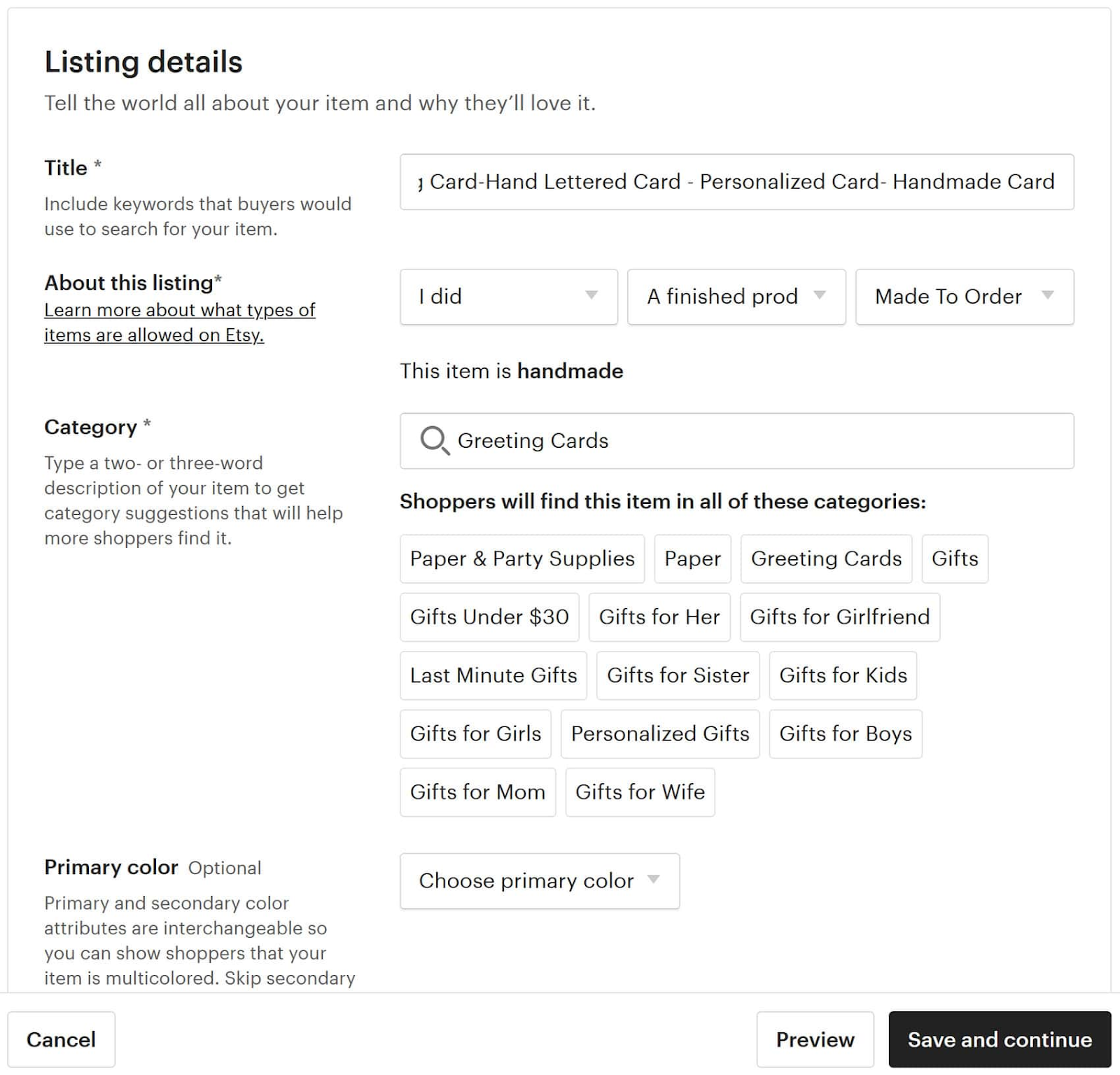
Further reading: Learn how to boost your Etsy shop’s visibility to get more sales with Etsy SEO: An 8-Step Guide.
Social Media Shopping
Several social media platforms now offer ecommerce options for sellers.
That means companies can direct users to website product pages or offer in-app purchasing options right from their social shares.
More than a quarter of internet users aged 16 to 64 use social media to discover new brands, products, and services according to research by GWI. People in your target market likely use these platforms. And they’re open to shopping there too.
Let’s look at an example from Free People’s Instagram profile:

When you tap the screen, you can click to see more information about applicable products.
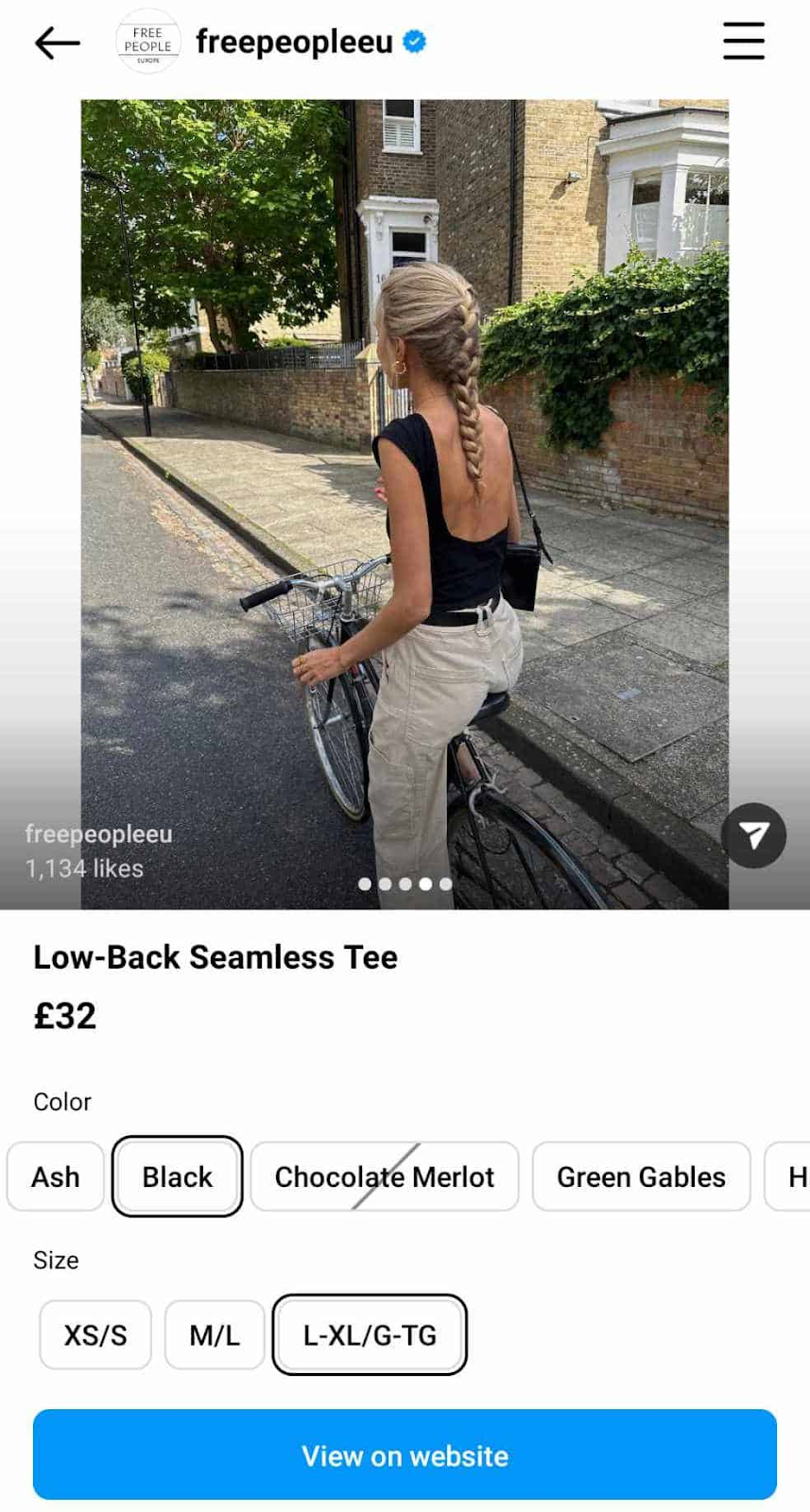
Some brands let you buy right within the app. Others direct you to their site to complete your purchase.
Popular platforms for social media shopping include:
- Facebook Shopping
- Instagram Shopping
- TikTok Shop
- Pinterest Shop
Facebook and Instagram Shopping
Facebook and Instagram are part of Meta. You can set up your online store for both in one place.
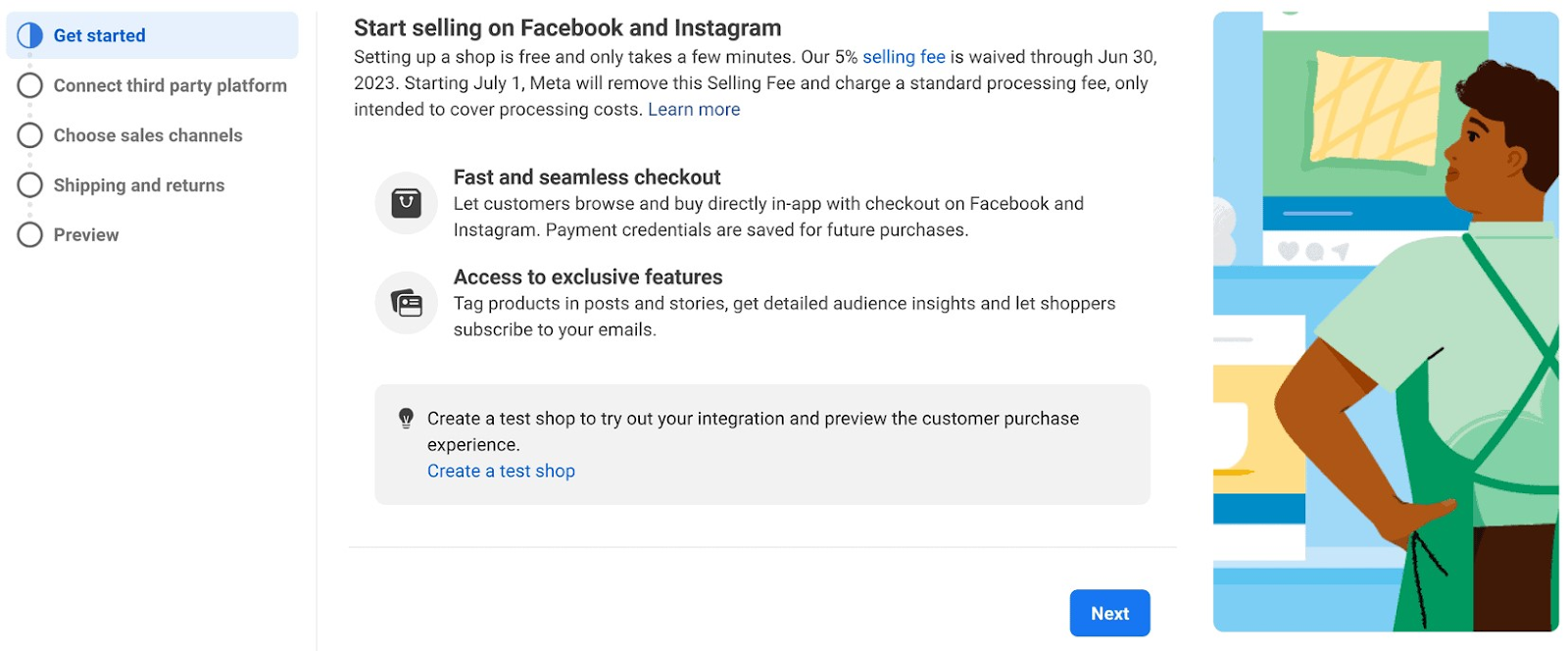
And you can integrate your shop with Facebook Messenger and WhatsApp to further reduce friction and ensure seamless purchases.
It’s free to list your items on Meta but you may be charged a commission depending on how you sell.
TikTok Shop
TikTok requires company information and certified identification when you apply to sell there.
Once you’re on the app, you can sell through LIVE, videos, and store pages.
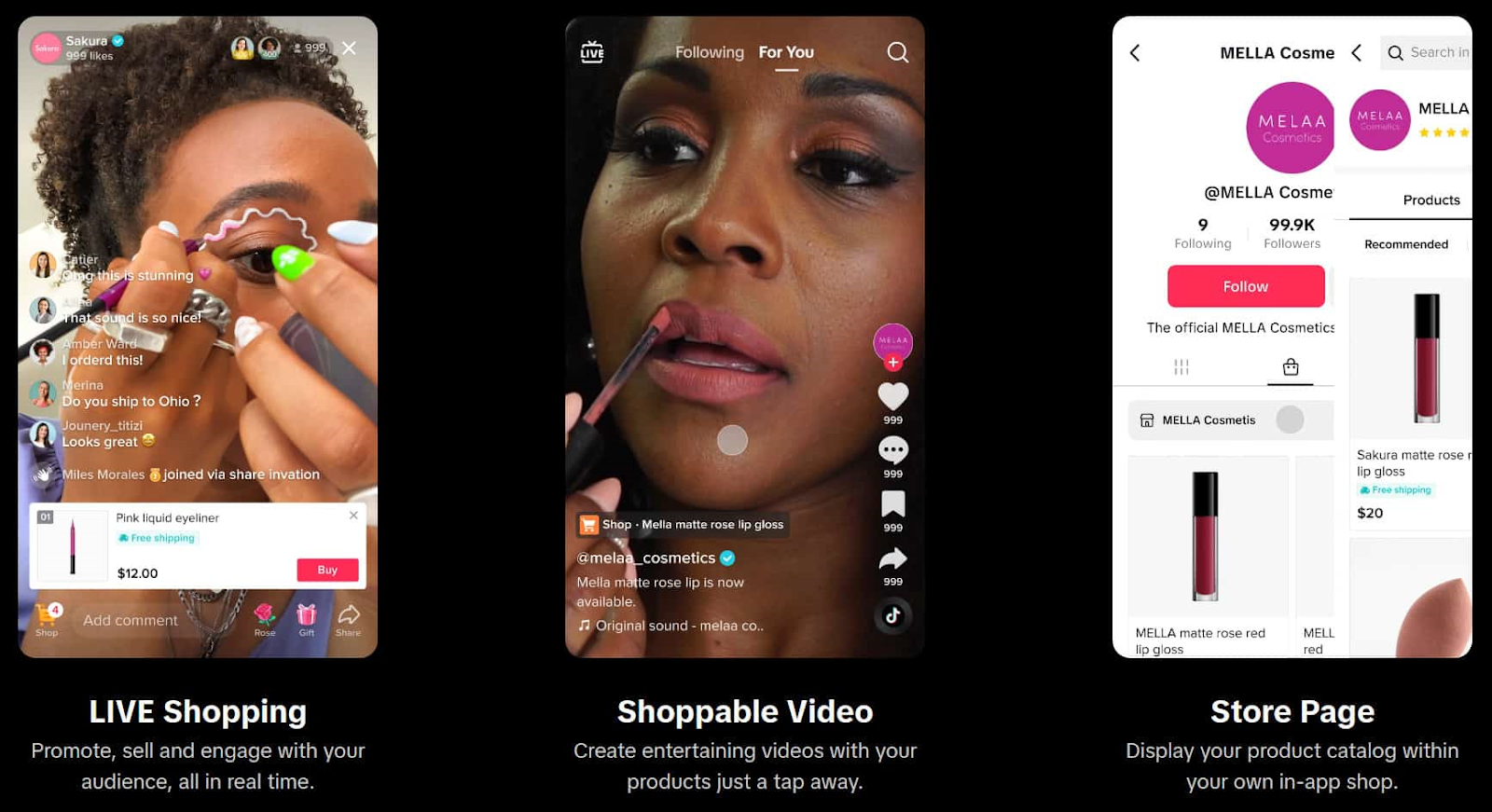
The TikTok Shop is available for:
- Creators
- Sellers
- Partners
- Affiliates
When an item is purchasable on the platform, a little orange shopping cart icon appears in the lower-left corner of the video in which that item is showcased.
The platform charges commission and transaction fees.
Pinterest Shopping
To list products on Pinterest, you need an online store and a Pinterest Business account.
You can also sign up for the Verified Merchant Program for up to 17% higher conversion rates.
Once you’ve connected your online store and Pinterest Business account, tag your product in Pins to sell them.
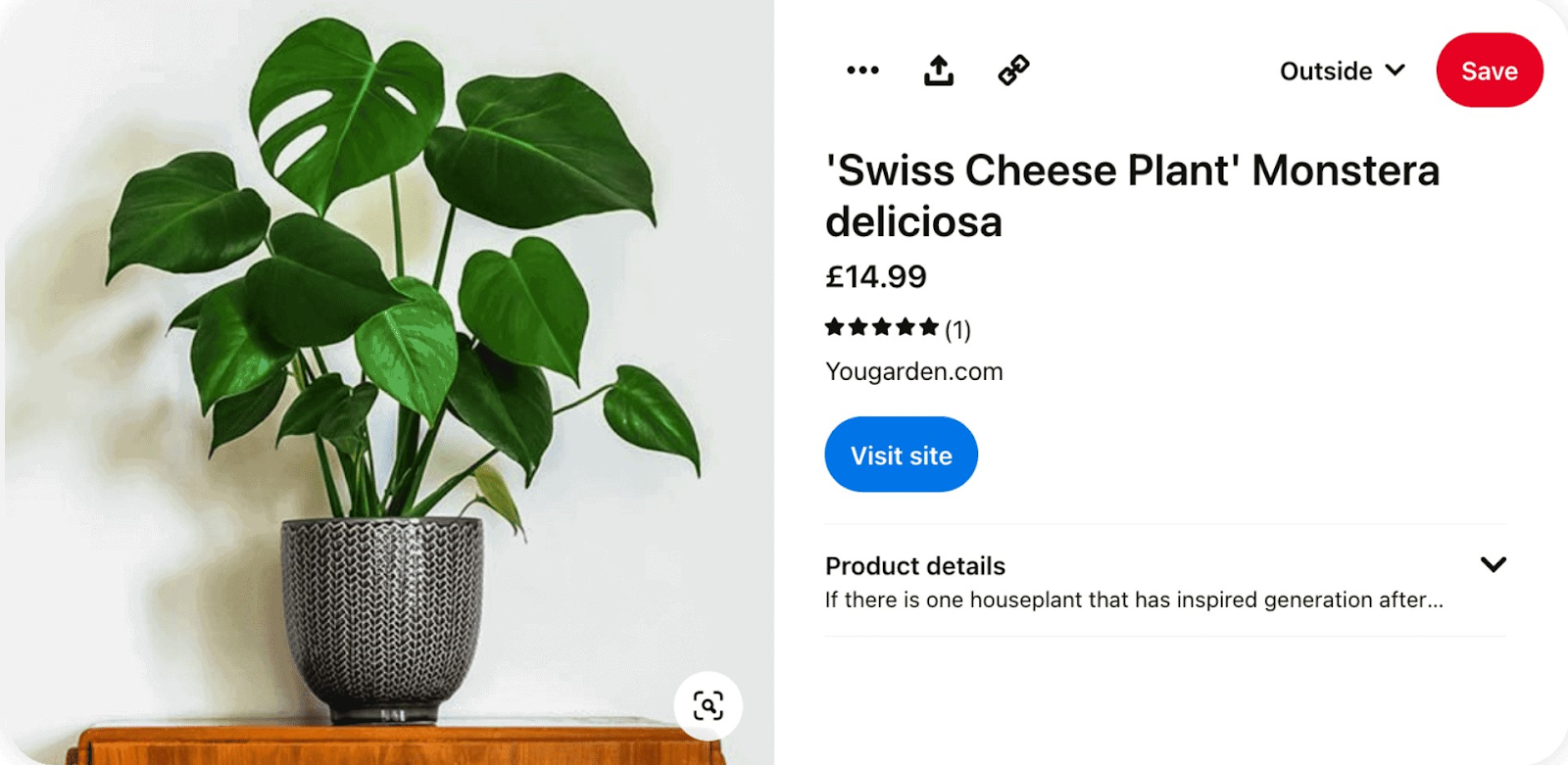
Pinterest directs customers to your linked ecommerce site when they click on tagged products.
The right platform choices for you depend on where your target audience hangs out. There’s no point spreading yourself too thin to get on a channel that few potential customers even use.
3 Multichannel Ecommerce Software Solutions for Small Businesses
Stressed at the idea of selling on and managing inventory across multiple platforms?
Don’t worry.
Multichannel ecommerce software solutions streamline your inventory and sales processes. They centralize them in one place. You can even use automations to make diversifying your ecommerce channel portfolio a breeze.
Here are three of the best multichannel ecommerce software tools to consider:
1. Ecommerce Apps on Semrush
Semrush offers a suite of apps for ecommerce stores to help optimize your product pages and drive more sales.
Let’s look at an example.
Here’s what your dashboard could look like using Search Insights for Amazon:

Notice: You can use metrics and competitive insights to increase your product’s visibility on Amazon.
Here are some more ecommerce solutions from Semrush:
- Ecommerce Booster: Boost your Shopify sales with a data-driven plan
- Product Research for Amazon: Find winning products to sell on the platform
- Listing Quality Check for Amazon: Audit your Amazon listings and learn how to increase their visibility and conversion rates
- Product Feed Health Checker: Ensure the search engine ranks your product in Google Shopping
- Consumer Surveys: Monitor consumer sentiment and behavioral trends
- Competition Tracker for Amazon: Keep an eye on your Amazon competitors
(Each of the above has a free plan or trial available for Semrush users.)
Let’s take a closer look at Ecommerce Booster.
This handy tool audits your product’s Shopify page performance in four areas:
- Written content
- User experience (UX)
- Visual content
- Page speed and accessibility
Simply enter the URL of your Shopify store into the search box and click “Analyze.”
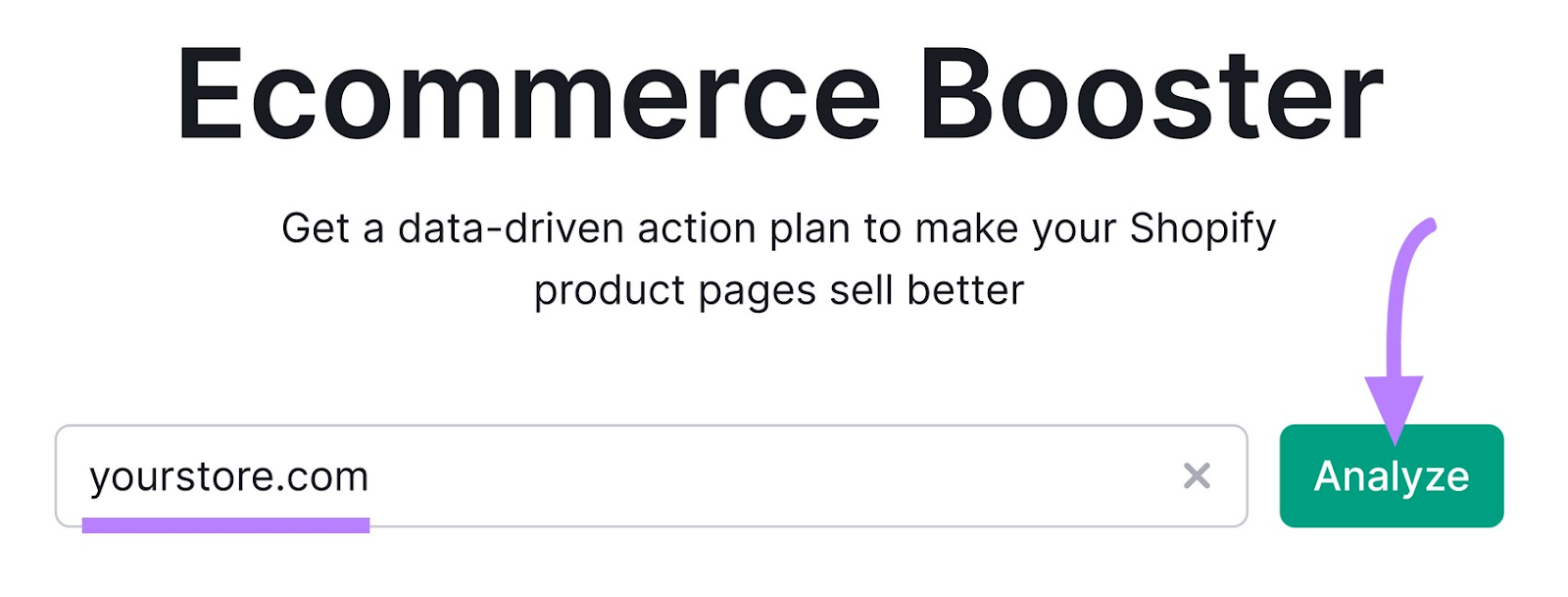
When the audit completes, you’ll see a to-do list with tasks to improve specific product pages.
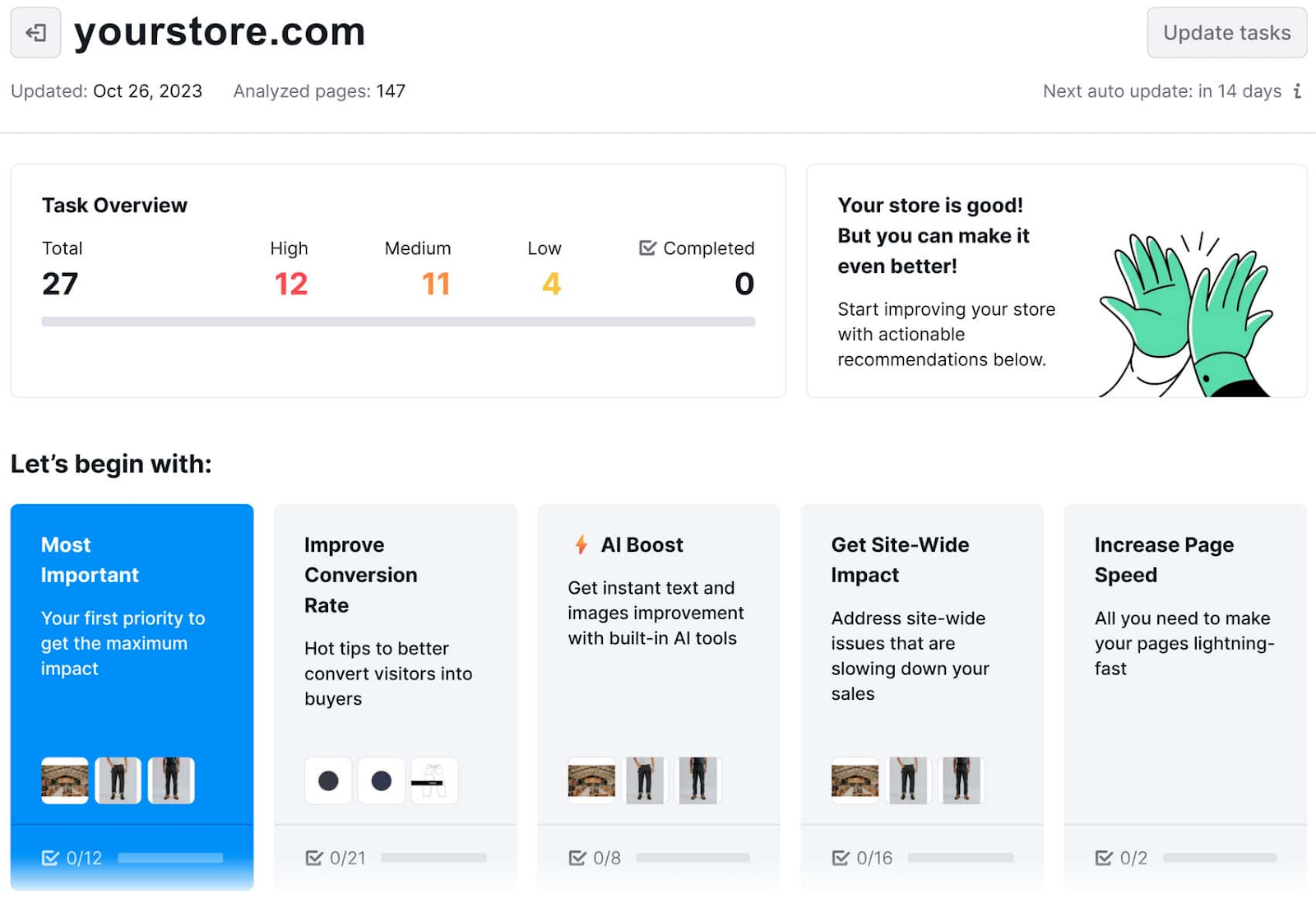
The artificial intelligence (AI) feature can help rewrite product descriptions and improve images.
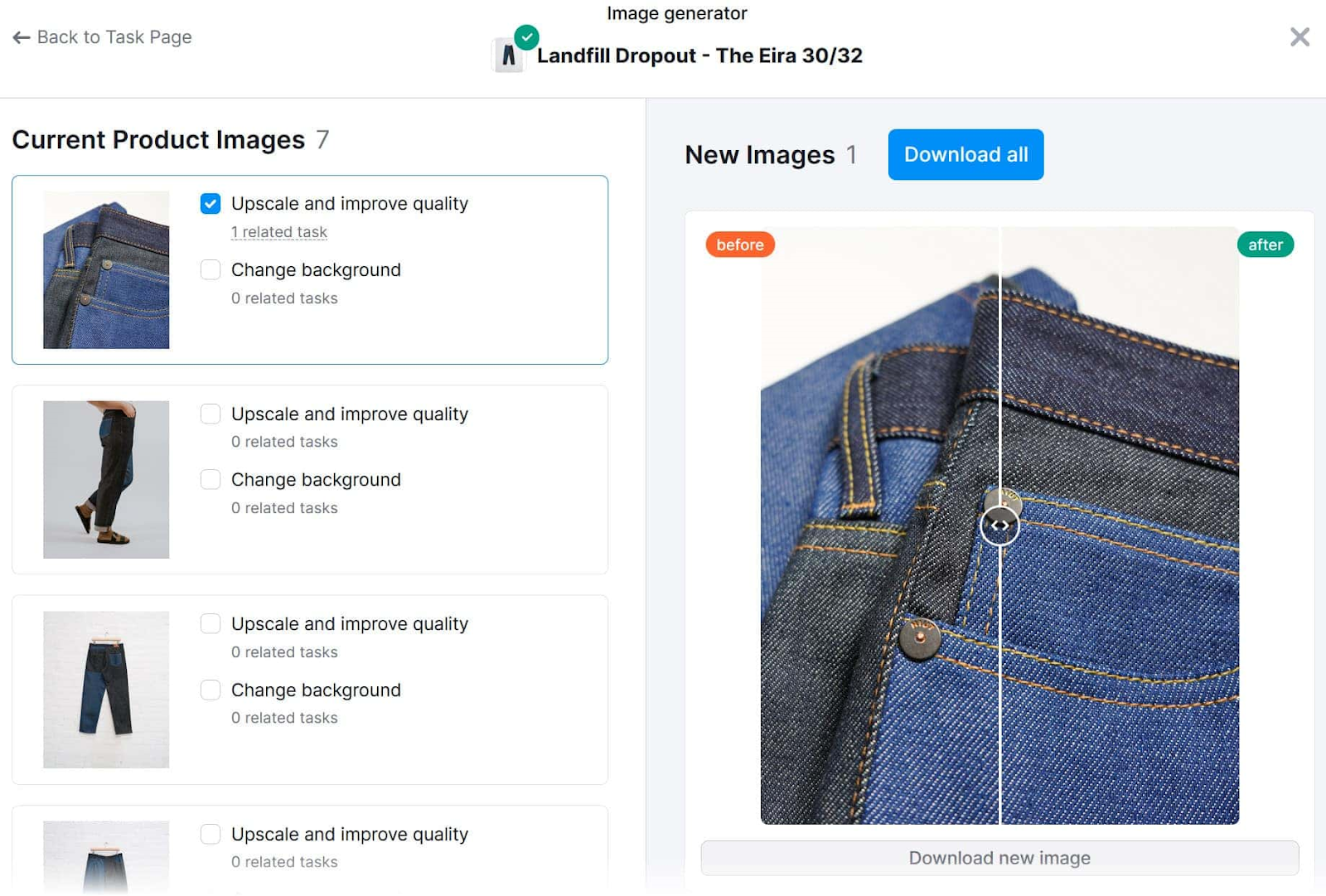
Why is this important?
Because your listings have to be attractive to potential customers when you sell on any channel. Otherwise, they’ll opt for a similar item that looks and sounds better online.
The suite of apps from Semrush can help you optimize your multichannel strategy for Shopify, Amazon, and Google Shopping.
2. Sellbrite
Sellbrite is a multichannel inventory tool that helps retailers list and sell products in online marketplaces.
Instead of jumping between platforms, use this multichannel ecommerce software to keep everything in one place.
Your Sellbrite dashboard could look like this:
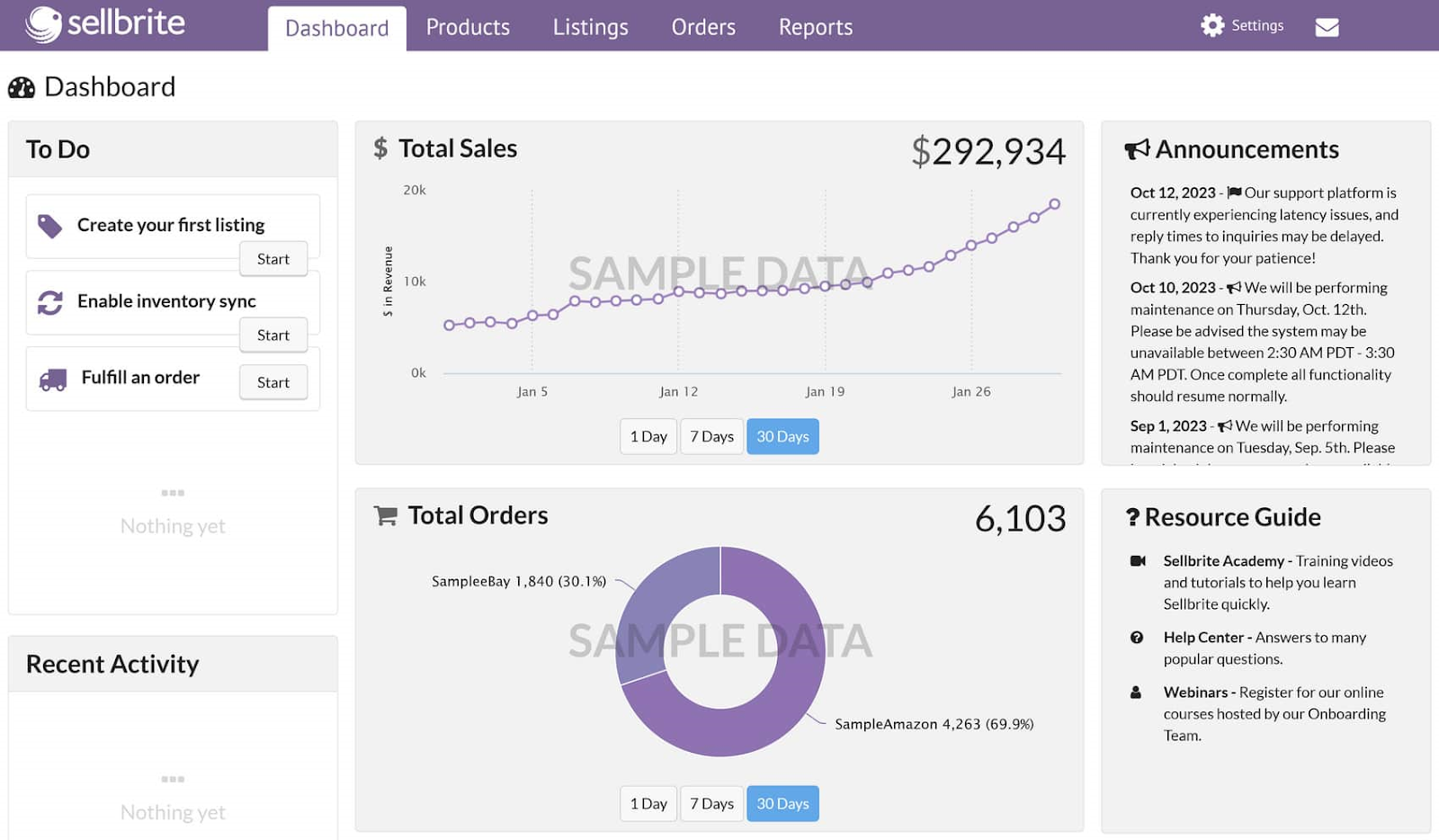
Track the status of your listings, channels you sell on, orders, and more.
You might choose Sellbrite because:
- You can use it to sell on platforms like eBay, Google, Walmart, and Etsy
- You can bulk-list your inventory to keep an eye on available, reserved, and out-of-stock items
- You can prevent overselling with multichannel inventory that syncs across sales channels in real-time
- Your listings and pricing automatically update from one centralized location
- You can print shipping labels from your dashboard and get USPS discounts
- You can optimize your strategy with valuable insights from data-driven reports
Using the tool, your Amazon listings manager may look like this:
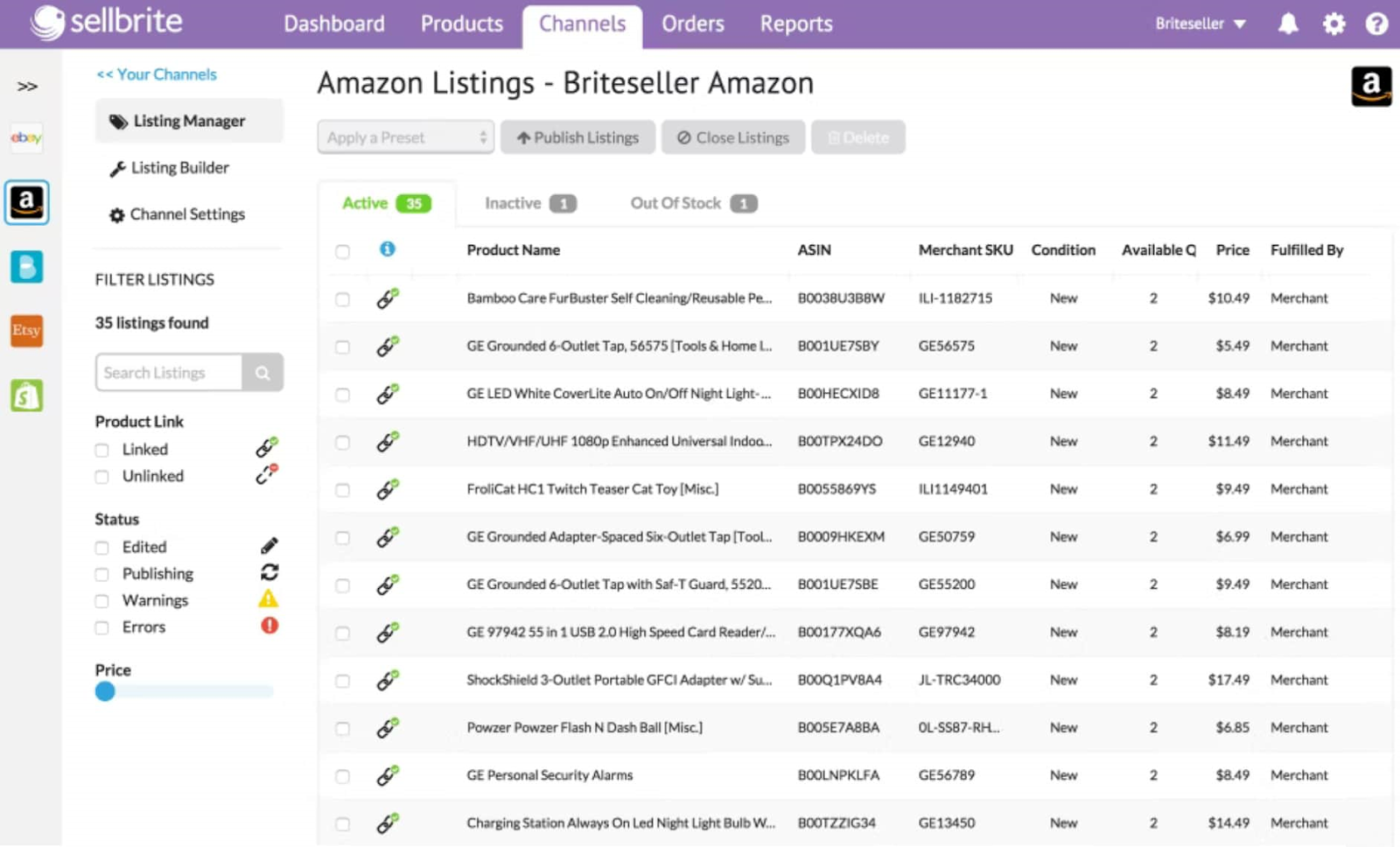
mage Source: Sellbrite / Capterra
Sellbrite splits your inventory into clear lists for a comprehensive overview of your stock and fulfillment settings. Crucial codes like Amazon Standard Identification Numbers (ASINs) and stock-keeping units (SKUs) are included.
Intending to sell on multiple US marketplaces? Sellbrite is perfect for those who want to manage these channels on one easy-to-use interface.
3. Adobe Commerce (Formerly Magento)
Adobe Commerce is an AI-powered multichannel ecommerce solution that supports business-to-business (B2B) and business-to-consumer (B2C) business models.
This feature-rich multichannel ecommerce platform suits those looking to scale quickly.
Here’s what your Adobe Commerce dashboard could look like:
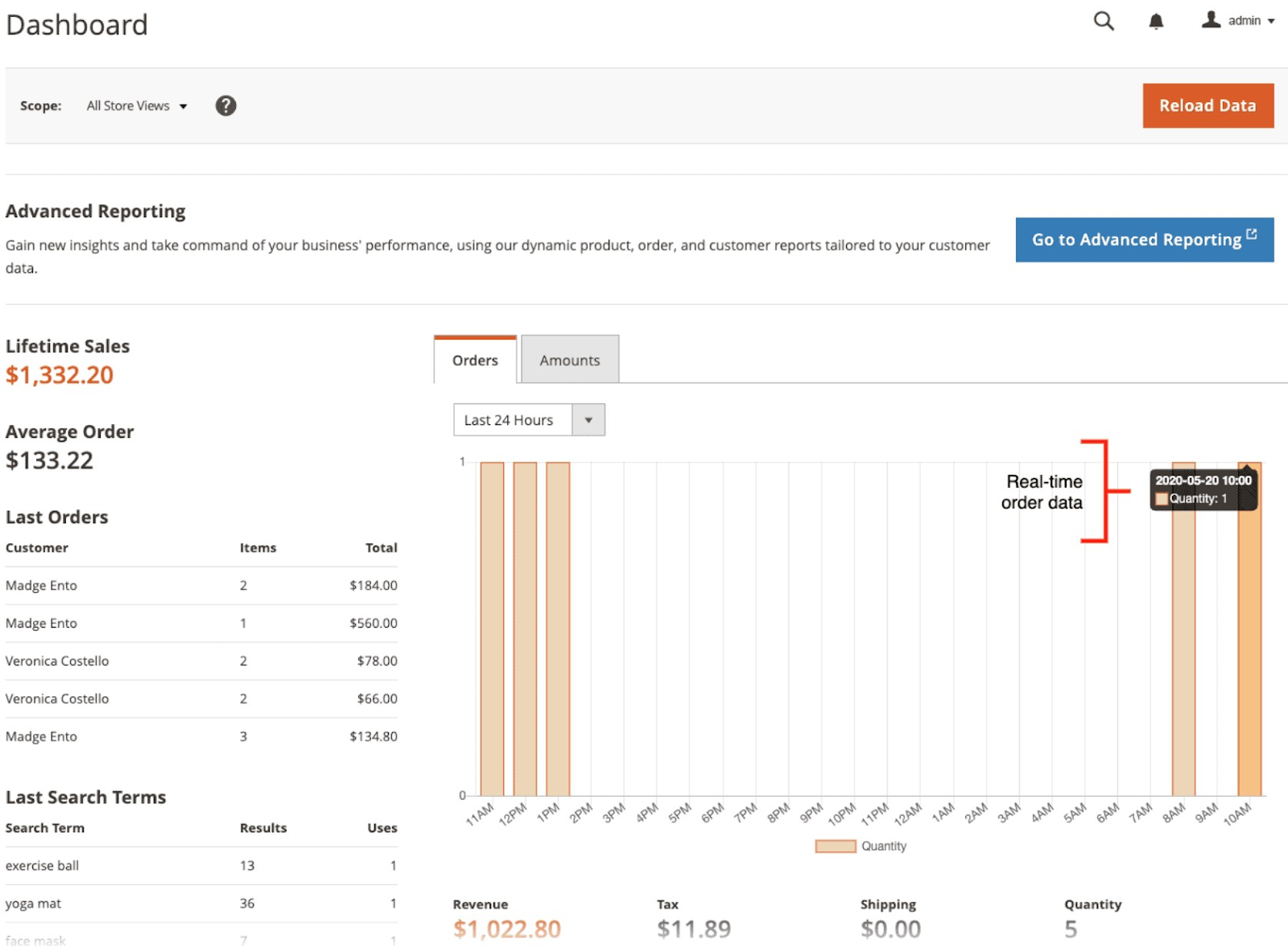
Image Source: Adobe
This real-time sales and customer data overview helps you keep on top of each channel’s finances. You can quickly identify your top performers.
You might choose Adobe Commerce because:
- You have the support and experience of an industry giant that promises security
- You can easily integrate with other Adobe products like InDesign and Photoshop
- You can expand into new geographies and connect your other brands to one dashboard
- You can deliver personalized promotions and self-service omnichannel fulfillment options
- You can take advantage of a platform developed especially for B2B businesses
- You can create highly customized dashboards to turn your data into visual reports
Thanks to Adobe’s acquisition of Magento, you can expect a high level of personalized metrics and configurations like these:
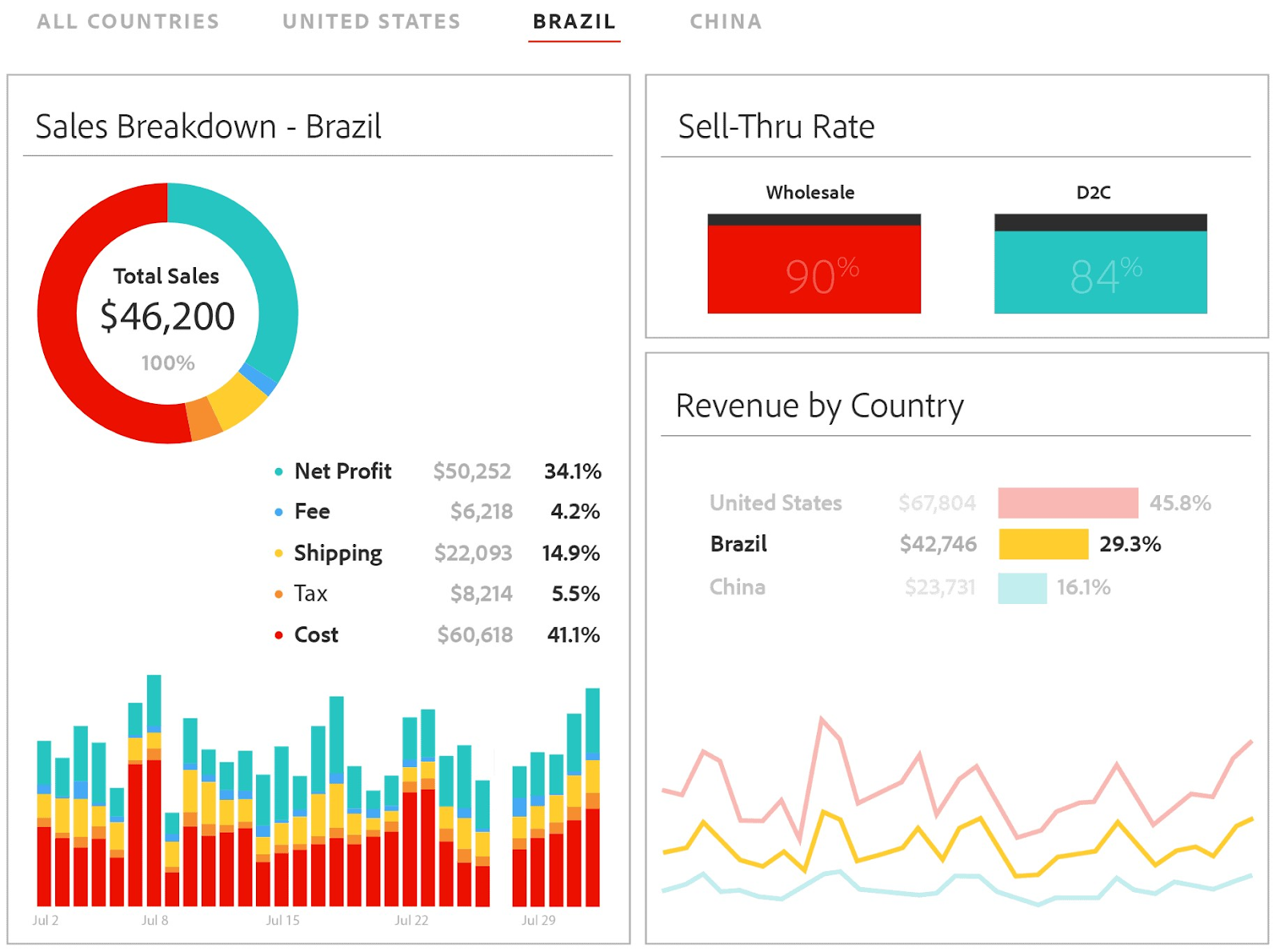
Image Source: Adobe
These numbers help you identify your most loyal customers and top-performing products. Plus, you can store and analyze all your data in one place.
Global brands like Coca-Cola and Krispy Kreme rely on Adobe Commerce. If you aspire to scale your business in a similar way, this platform can help you do it.
Streamline Your Multichannel Ecommerce Strategy with Semrush
The success of your multichannel ecommerce strategy doesn’t just depend on the quality of your products.
Your copy, visuals, and user experience all play a part in making a sale. And you need software that gives you control over each element.
Instead of expensive all-in-one tools, Semrush gives you a la carte access to apps. That means you only pay for the functionality you’ll use.
Ready to get started? Head to our ecommerce collection and optimize your Amazon, Shopify, and Google Shopping listings today.
